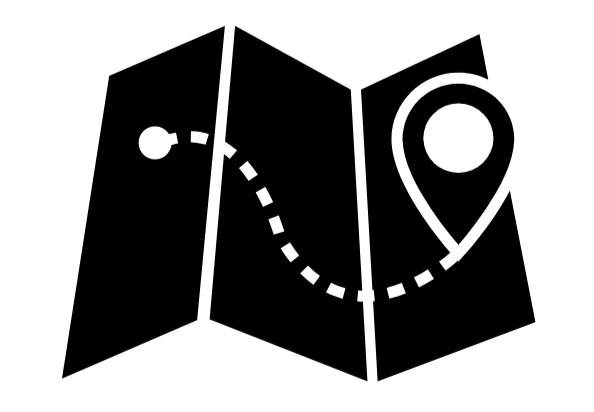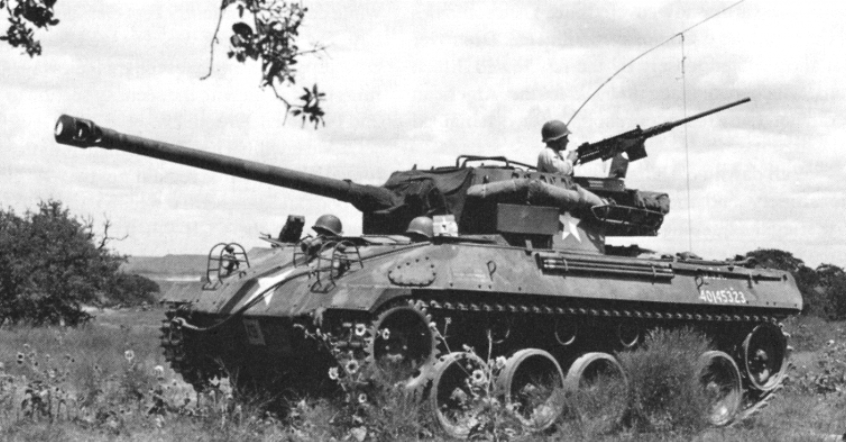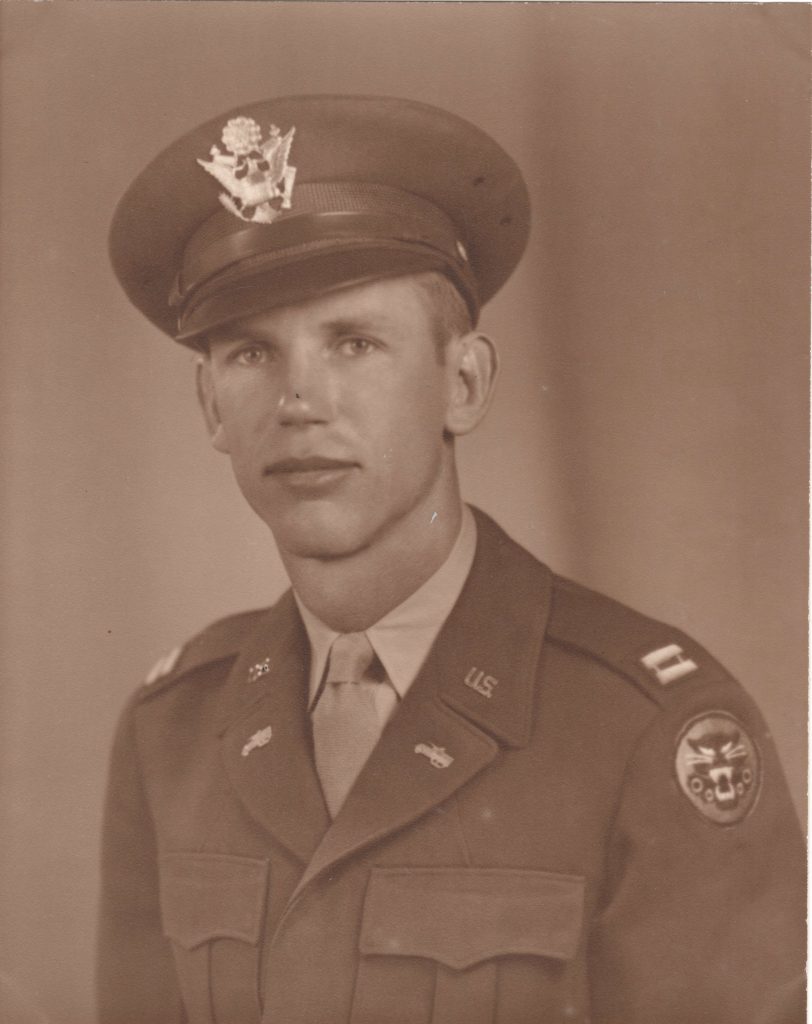
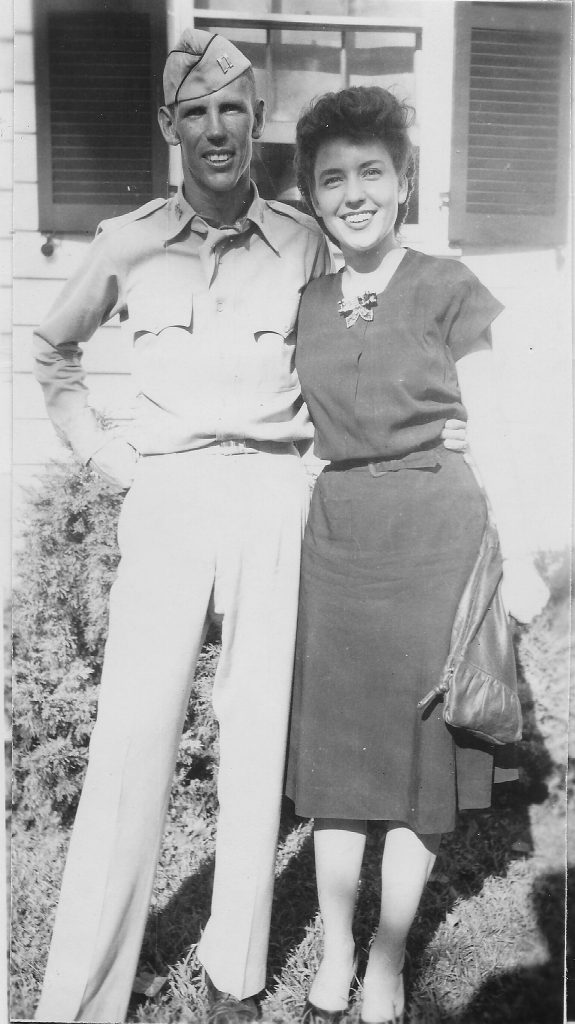
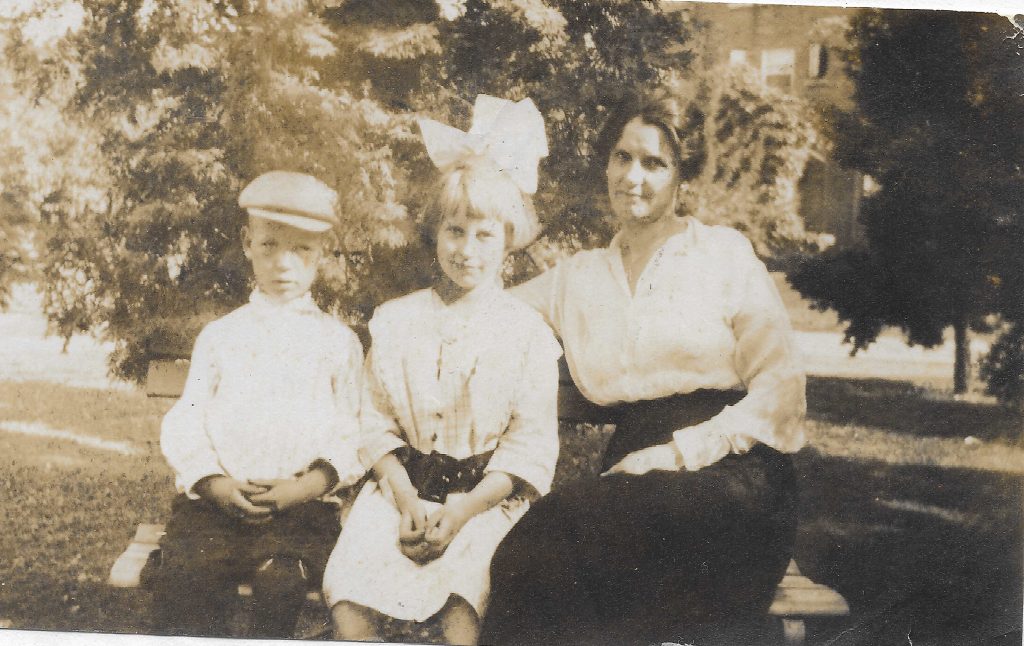

My Life's Story
January 27, 1912
Midvale, Utah
January 31,1999
San Juan Capistrano, California
Autobiography of Howard Kenneth Lundeen Written in 1961 Original Manuscript
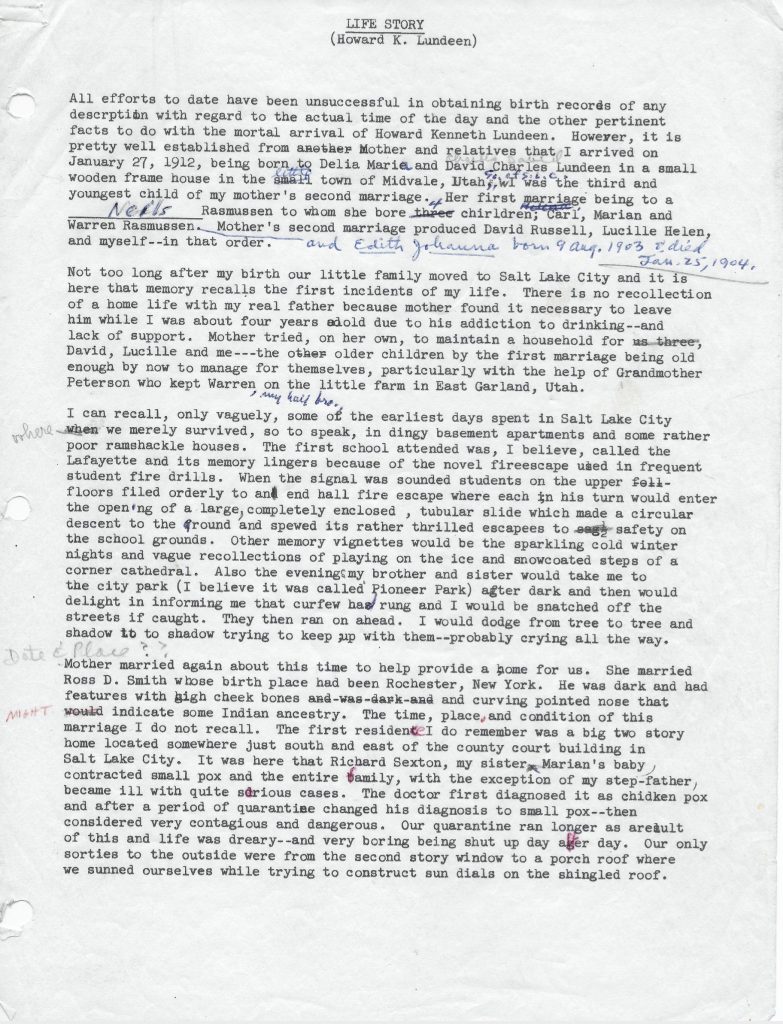
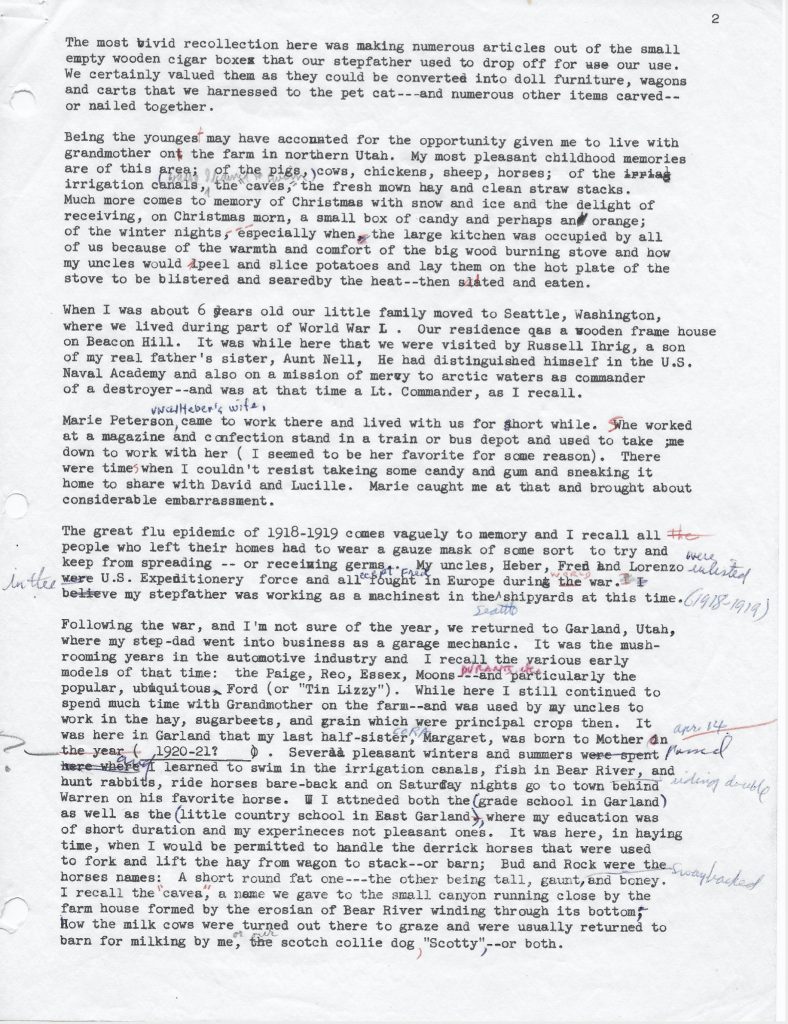
I arrived on January 27, 1912, being born to Delia Maria and David Charles Lundeen in a small wooden frame house in the little town of Midvale, Utah. I was the third and youngest child of my mother’s second marriage. Her first marriage being to a Neils Rasmussen to whom she bore 4 children; Carl, Marian, Edith Johanna and Warren Rasmussen. Mother’s second marriage produced David Russell, Lucille Helen, and myself– in that order.
Not too long after my birth our family moved to Salt Lake City and it is here that memory recalls the first incidents of my life. There is no recollection of a home lifw with my real father because mother found it necessary to leave him while I was about four years old due to his addiction to drinking– and lack of support. Mother tried, on her own, to maintian a household for David, Lucille and me– the other older children by the first marriage being old enough by now to manage for themselves, particularly with the help of Grandmother Peterson who kept Warren on the little farm in East Garland, Utah.
I can recall, onlyd vaguely some of the earliest days spent in Salt Lake City we merely survived, so to speak, in dingy basement apartments and some rather poor ramshackle houses. The first school attednded was, I believe, called the Lafayette an it’s memory lingers because of the novel firescape used in frequent student fire drills.
Mother married again about this time to help provide a home for us. She married Ross D. Smith whose birth had been Rochester, New York. He was dark and had features with high cheek bones and was dark with a curving pointed nose that would indicate some Indian ancestry. The time, place, and condition of this marriage I don’t recall. The first residence I do remeber was abig two story home located somewhere just south and east of the county court building in Salt Lake City. It was here that Richard Sexton, my sister, Marian’s baby contracted small pox and the entire family, with the exception of my step-father became ill with quite serious cases. The doctor first diagnosed it as chicken pox and after a perio of quarantine changed his diagnosis to small pox — considered very contagious and dangerous. Our quarantine ran longer as a result of this and life was dreary– and very boring being shut up day after day. Our only sorties to the outside were from the second story window to a porch roof where we sunned ourselves while trying to construct sun dials on the shingle roof,
The most vivid recollection here was making numerous articles out of the small empty wooden cigar boxes that our stepfather used to drop off for our use. We certainly valued them as they could be converted into doll furniture, wagons and carts that we harnessed to the pet cat– and numerous other items carved — or nailed together.
Being the youngest may have accounted for the opportunity given me to live with grandmother Peterson on the farm in Northern Utah. My most pleasant childhood memories are if this area; of the pigs, cows, chickens, sheep, horses; of the irrigation canals, the caves, the fresh mown hay and clean straw stacks.
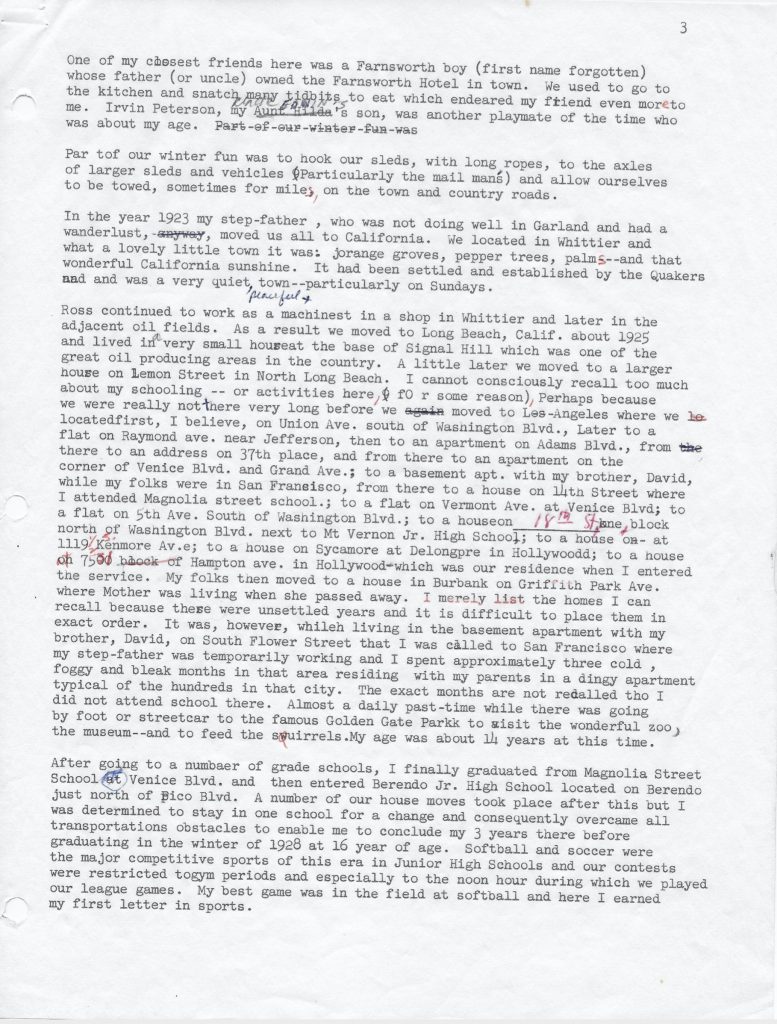
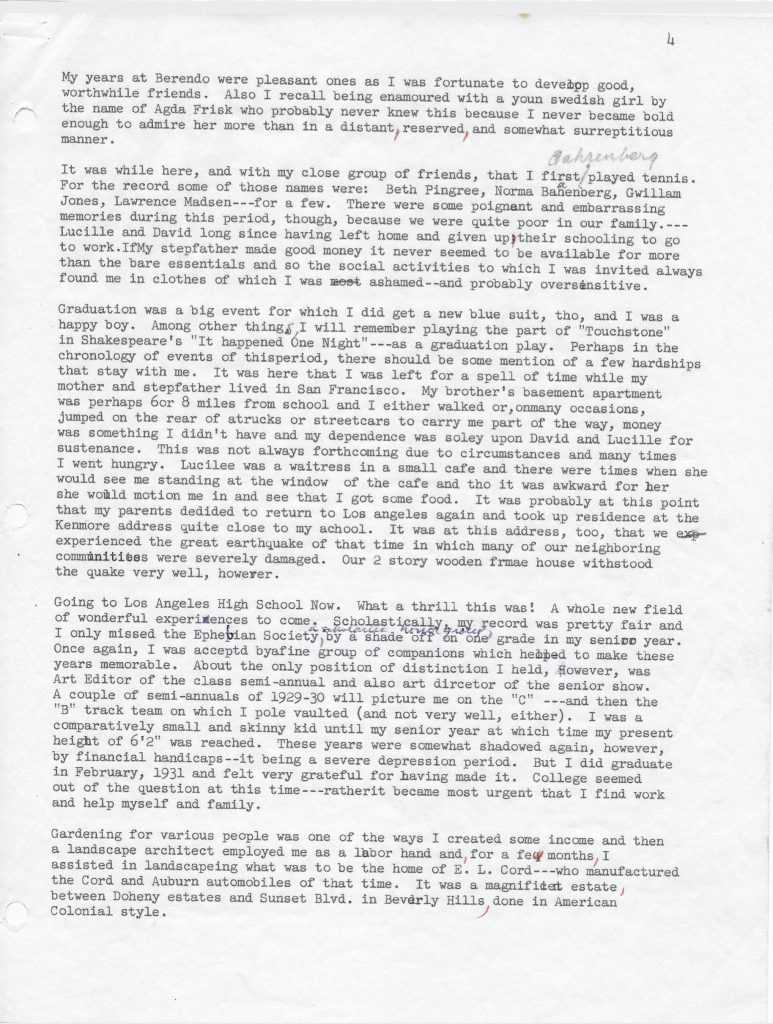
One of my closest friends here was a farnsworth boy whose father owned the Farnsworth hotel in town. We used to go to the kitchen and snatch many tidbits to eat which endeared my friend even more to me. Grandma Hilda’s son Irvin Peterson (my uncle) was another playmate of the time who was about my age.
Part of our winter fun was to hook our sleds, with long ropes, to the axles of larger sleds and vehicles, (particularly the mail mans) and allow ourselves to be towed, sometimes for miles, on the town and country roads.
In the year 1923 my step-father, Ross who was not doing well in Garland and had a wanderlust, moved us all to California. We located in Whittier and what a lovely town it was; orange groves, pepper trees, palms and that wonderful California sunshine.
Ross continued to work as a machinist in a shop in Whittier and later in the adjacent oil fields. As a result we moved to Long Beach Calif. about 1925 and lived in a very small house at the bas of Signal Hill which was one of the great oil producing areas in the country. A little later we moved to a larger house on Lemon Street in North Long Beach. I cannot consciously recall too much about my schooling– or activities here for some reason.


We really weren’t there long before moving to Los Angeles where we located first, I believe, on Union Avenue, south of Washington Blvd. Later we moved to a flat on Raymond Avenue near Jefferson; then to an apartment on Adams Blvd; to an address on 37th Place; to an apartment on the corner of Venice Blvd and Grand Avenue; to a basement apartment with my brother David while my folks were in San Francisco; to a house on 14th Street where I attended Magnolia Street School; to a flat on Vermont Avenue at Venice Blvd; to a flat on 5th Avenue, south of Washington Blvd; to a house on 18th Street, one block north of Washington Blvd; to a house at 1119-1/2 Kenmore Avenue; to a house on Sycamore at Delongpre in Hollywood; and then to a house at 7531 Hampton Avenue in Hollywood which was our residence when I entered the service. My folks then moved to a house in Burbank on Griffith Park Ave, where Mother was living when she passed away of uterine cancer.
I merely list the homes I can recall because these were unsettled years. It is difficult to place them in exact order. It was, however, while living in the basement apartment with my brother David on South Flower St., that I was called to San Francisco where my stepfather was temporarily working. I spent approximately three cold, foggy and bleak months in that area residing with my parents in a dingy apartment, typical of hundreds in the city. I did not attend school there. I was about fourteen at that time.
After going to a number of grade schools, I finally graduated from Magnolia Street School and then entered Berendo Jr. High School. A number of our house moves took place after this but I was determined to stay in one school for a change and consequently overcame all transportation obstacles to enable me to conclude my 3 years there before graduating in the winter of 1928 at 16 years of age. Softball and soccer were the major competitive sports of this era in Junior High Schools and our contests were restricted to gym periods and especially to the noon hour during which we played our league games. My best game was in the field at softball and here I earned my first letter in sports.
Howard Graduated from Berendo Jr. High School
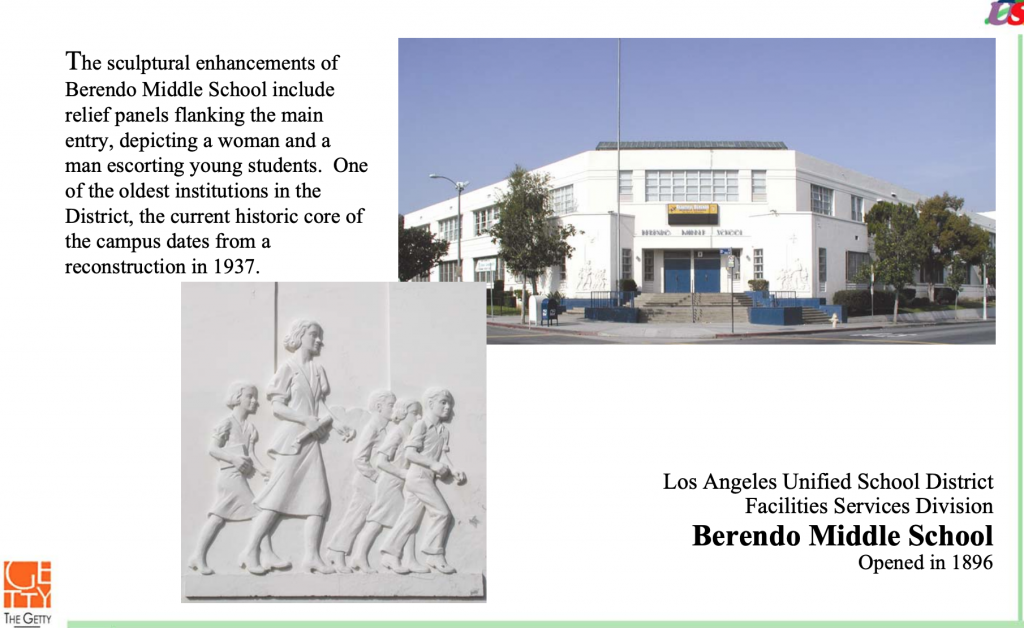
My years at Berendo were pleasant ones as I was fortunate to develop good worthwhile friends. Also I recall being enamoured with a young Swedish girl by the name of Agda Frisk, who probably never knew this because I never became bold enough to admire her more than in a distant, reserved, and somewhat surreptitious manner.
It was while here, with my close group of friends, that I first played tennis. For the record some of those names were; Beth Pingree, Norma Bahrenberg, William Jones, Lawrence Madsen— For a few. There were some poignant and embarrassing memories during this period, though because we were quite poor in our family. Lucille and David long since having left home and given up their schooling to go to work. If my stepfather made good money, it never seemed to be available for more than the bare essentials and so the social activities to which I was invited always found me in clothes of which I was ashamed– and probably oversensitive.
Graduation was a big event for which I did get a new blue suit, tho, and I was a happy boy. Among other things, I will remember playing the part of “Touchstone” in Shakespeare’s ” It happened One Night”, as a graduation play. Perhaps in the chronology of events of this period, there should be some mention of a few hardships that stay with me. It was here that I was left for a spell of time while my mother and stepfather lived in San Francisco. My brother’s basement apartment was perhaps 6 or 8 miles from school and I either walked or, on many occasions jumped on the rear of a truck or streetcars to carry me part of the way, money was something I didn’t have and my dependence was solely upon David and Lucille for sustenance. This was not always forthcoming due to circumstances and many times I went hungry. Lucile was a waitress in a small cafe and there were times when she would motion me in and see that I got some food. It was probably at this point that my parents decided to return to Los Angeles again and took up residence at the Kenmore address quite close to my school. It was at this address, too that we experienced the great earthquake of that time in which many of our neighboring communities were severely damaged. Our two story wooden frame house withstood the quake very well, however.
Long Beach earthquake of March 1933, a 6.4-magnitude temblor that ruptured the Newport-Inglewood Fault along the coast, toppling scores of buildings and killing 115 to 120 people, the highest death toll on record from a Southern California earthquake.
1933 Long Beach Earthquake Magnitude 6.4

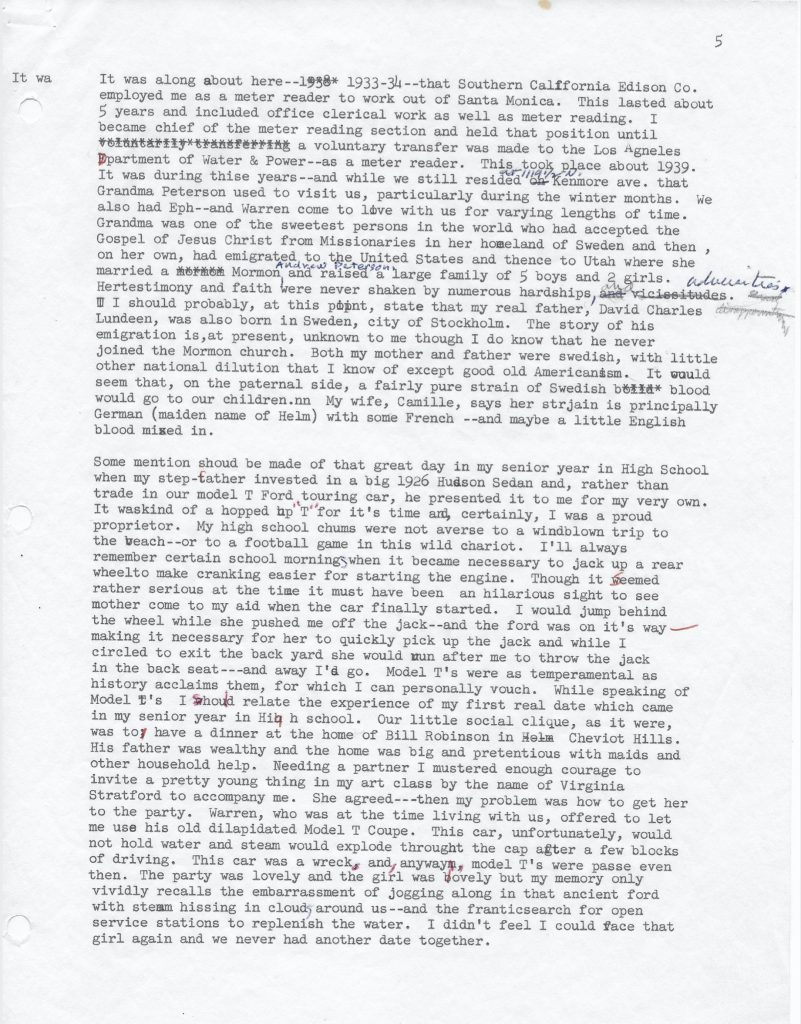
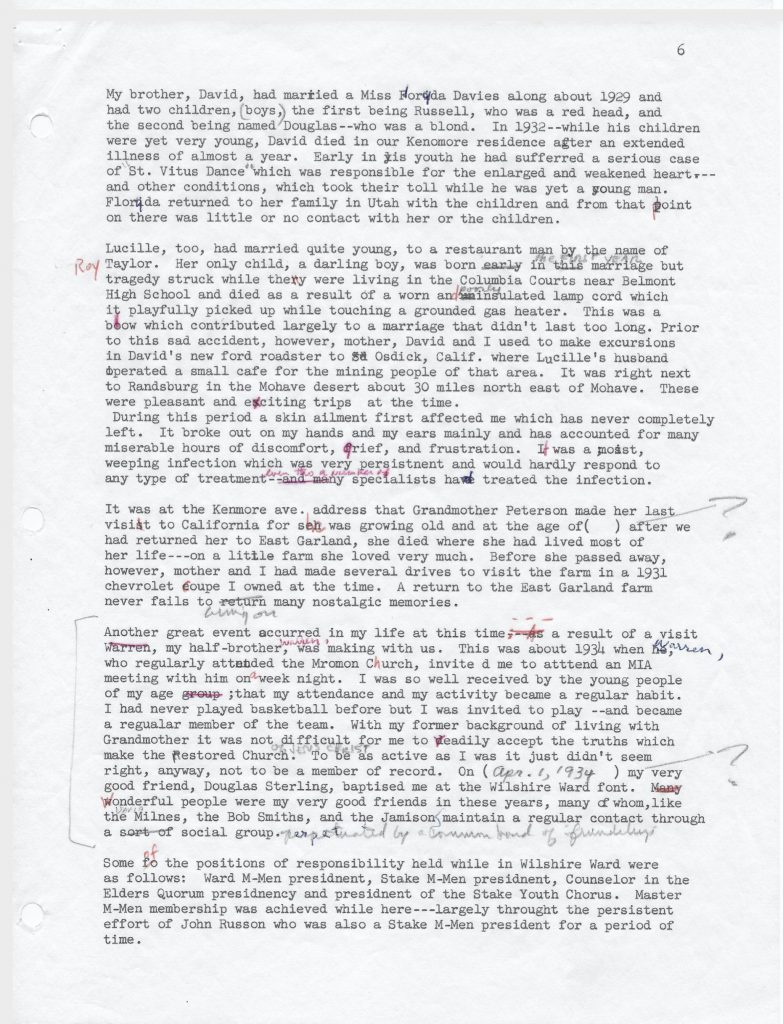
It wa along about here 1933-34 that Southern California Edison Co. employed me as a meter reader to work out of Santa Monia. This lasted about 5 years and incuded office clerical work as ws well as meter reading. I became chief of the meter reading section and held that position until a voluntary transfer was made to the Los Angles Department of water & Power as a meter reader. This took place about 1939. It was during this year and while we still resided at 11191/2 No. Kenmore Ave. that Grandma Peterson used to visit us, for varying lengths of time. Grandma was one of the sweetest persons in the world who had accepted the Gospel of Jesus Christ from Missionaries in her homeland of Sweden and then on heer own emmigrated to the United Stats and thence to Utah where she married a Andrew Peterson, and raised a large family of 5 boys and 2 girls. Her testimony and faith were never shaken by numerous hardships. I should probably state at this point my real father, David Charles Lundeen, was also born in Sweden, city of Stockholm. The story of his emigration is at present unknown to me though I do know that he never joined the Mormon church. Both my mother and father were Swedish, with little other national dilution taht I know of except good old Americanism. It would seem that on the paternal side, a fairly pure strain of Swedish blood would go to our children. My wife, Camille says her strain is prinipally German (maiden name of Helm) with some French and maybe a little English blood mixed in.
Some mention should be made of that great day in my senior year in High School when my step-father invested in a big 1926Hudson Seaan and rathe than trade in our model T Ford touring car, he presented it to me for my very own. I was certaintly a proud proprietor.My high school chums were not averse to a windblown trip to the beach or to a foot ball game in this wild chariot. I’ll always remember certain school mornings when it became necessary to jack up a rear wheel to make cranking easier for starting the engine. Though it seemed rather serious at the time it must have been a hilarious sight to see mother come to my aid when the car finally started. I would jump behind the whell while she pushed me off the jack and the ford was on it’s way, making it necessary for her to quickly pick up the jack and while I circled to exit the backyard she would run after me to throw the jack in the backseat and away I’d go. Model T’s were as temperamental as history acclaims them, for which I can personally vouch.
Howard and David Taking the Convertible Model T for a spin
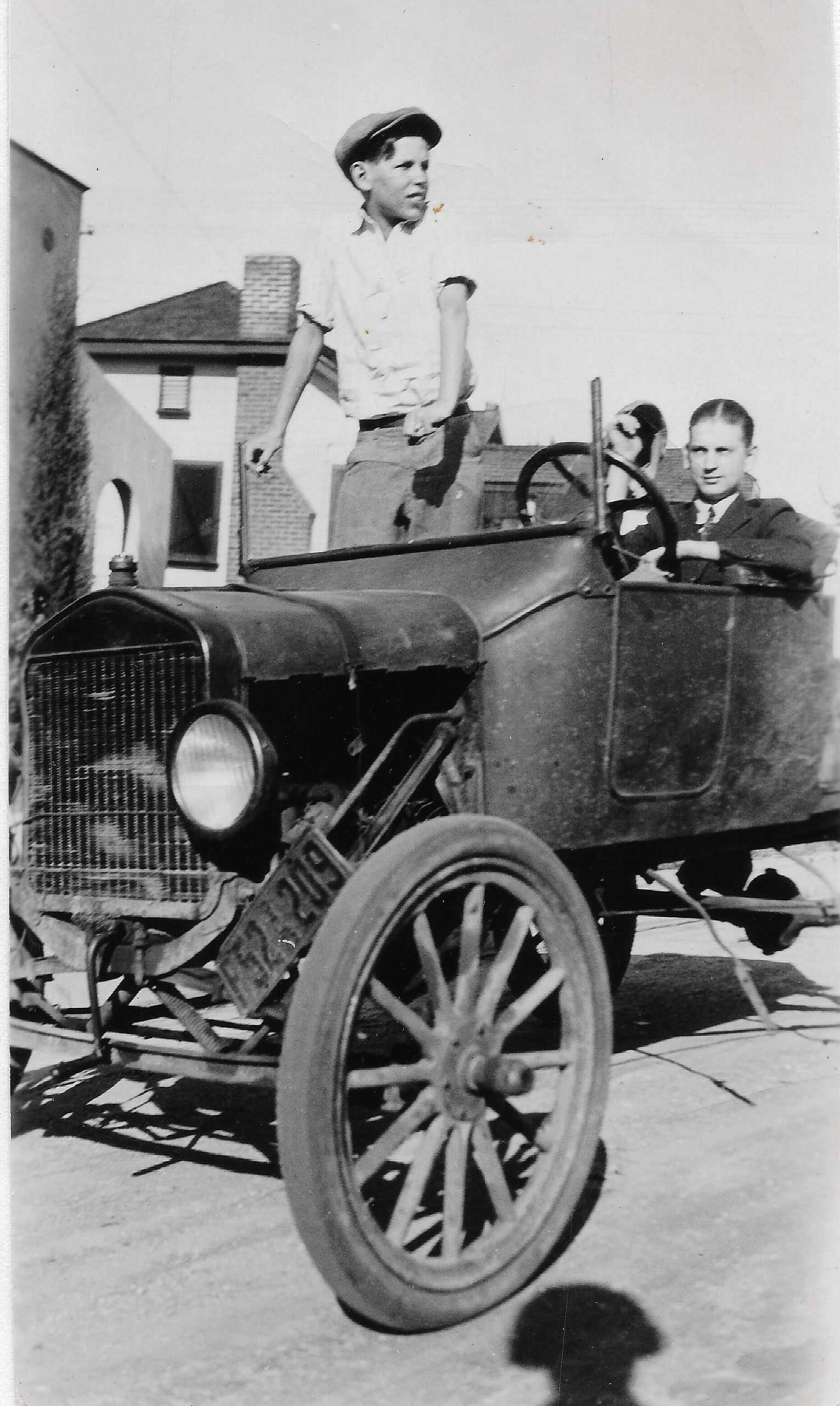
Howard with Delia, baby Margie, Grandma Peterson and Ross

David with the Model T

While speaking of Model T’s I should relate the experience of my first real date which came in my senior year in High School. Our little social clique, as it were, was to have a dinner at the home of Bill Robinson in Cheviot Hills. His father was wealthy and the home was a big pretentious with maids and other household help. Needing a partner I mustered enough courage to invite a pretty young thing in my art class by the name of Virginia Stratford to accompany me. She agreed then my problem was how to get her to the party. Warren, who was at the time living with us, offered to let me use his old dilapidated Model T Coupe. This car, unfortunately would not hold water and steam would explode through the cap after a few blocks of driving. This car was a wreck and anyway, model T’s were passe even then. The party was lovely and the girl was lovely but my memory only vividly recalls the embarrassment of jogging along in the ancient ford with steam hissing in clouds around us, and the frantic search for open service stations to replenish the water. I didn’t feel I could face that girl again and we never had another date together.
My brother, David, had married a Miss Floryda Davies about 1929 and had two children, boys, the first being Russell, who was a red head, and the second being named Douglas, who was blond. In 1932, while his children were yet very young, David died in our Kenmore Residence after an extended illness of almost a year. Early in his youth he had suffered a serious case of St. Vitus Dance, which was responsible for the enlarged and weakened heart as well as other conditions, which took their till while he was yet a young man. Floryda returned to her family in Utah with the children and from that point on there was little or no contact with her or the children.

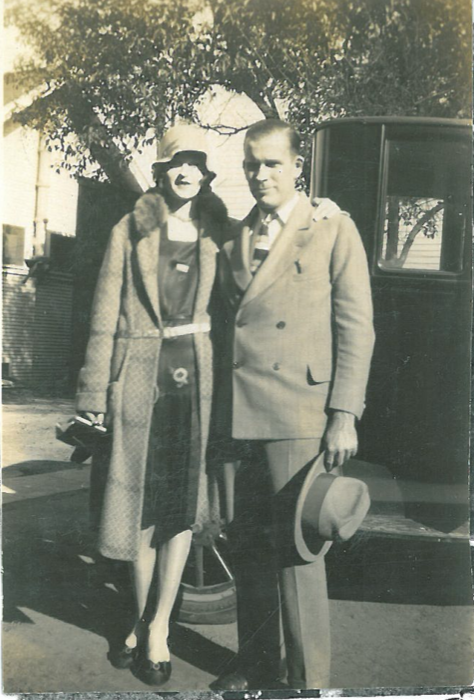
Lucille, too, had married quite young, to a restaurant man by the name of Roy Taylor. Her only child, a darling boy, the first year of marriage . Tragedy struck while they were living in Columbia Courts near Belmont High School and the baby died as a result of a worn and poorly insulated lamp cord ??? it playfully picked up while touching a grounded gas heater, which contributed largely to a marriage that didn’t last to long. Prior to this sad accident, however, mother , David and I used to make excursions in David’s new ford roadster to Osdick, Calif, where Lucille’s husband operated a small cafe for the mining people of that area. It was right next to Randsburg in the Mohave Desert about 30 miles north east of Mohave. These were pleasant and exciting trips at the time.
It was at the Kenmore Ave. address that Grandmother Peterson made her last visit to California for she was growing old. When she returned to East Garland, she died where she had lived most of her life, on a little farm she loved very much. Before she passed away, however, mother and I had made several drives to visit the farm in a 1931 Chevrolet coupe I owned at the time. A return to the East Garland farm never fails to bring back many nostalgic memories.
Another great event occurred in my life at this time as a result of a visit by Warren, my half-brother. This was about 1934 when Warren who regularly attended the Mormon Church invited me to attend an MIA meeting with him on a weeknight. I was so well received by the young people of my age, that my attendance and my activity became a regular habit. I had never played basketball before but I was invited to play and became a regular member of the team. With my former background of living with Grandmother it was not difficult for me to readily accept the truths which make the Restored Church. To be as active as I was it just didn’t seem right, anyway not to be a member of record. On April 1, 1934, my very good friend, Douglas Sterling, baptized me at the Wilshire Ward font. Because of the regular contact and social group, many wonderful people were my friends during these years such as Bob Smith, Jamison, and the Milnes.

Some of the positions of responsibility while in Wilshire Ward were as follows: Ward M-Men President, Counselor in the Elder’s Quorum Presidency and President of the Stake Youth Chorus. Master M-Men membership was achieved largely because of the efforts of a wonderful leader, John Russon who was the Stake Young Men’s President for a period of time.

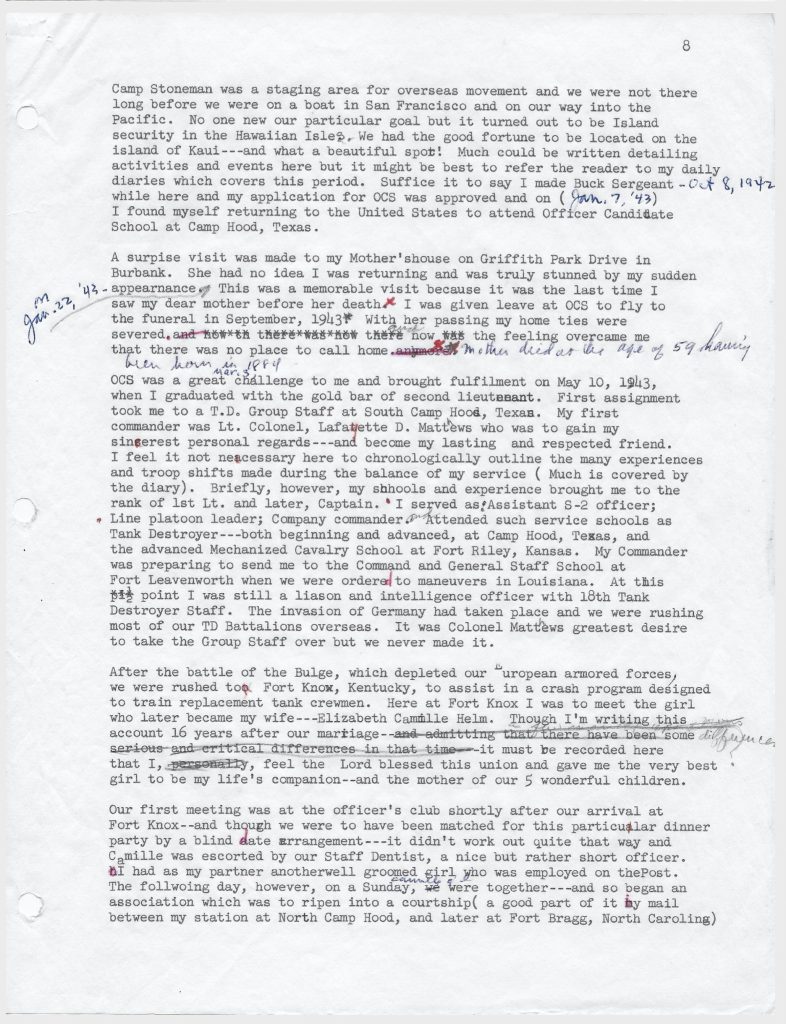
Bishop Howells was my first bishop and a wonderful man. Being a wealthy man he offered at tone time, to finance me on a mission for the Church. At the time I felt circumstances would still not permit me to go and refused this most generous offer. I have since regretted it. It was about this time I received my Patriarchal Blessing from Patriarch George Bowles, another wonderful man. (If you want a copy please email [email protected])
The M Men and Gleaner Youth Chorus of which I was President for a spell deserves more mention her because this was one othe most succuessful groups with whic I had been associated. We were led by a talented member . Nothing seemed too ambitious for us and among some of our accomplishments were: complete renditions of Handel’s “Messiah”, Easter Oratorio, “The Seven Last Words of Christ”. We accepted an invitation to sing in the tabernacle at June Conference in Salt Lake City. We sung several performances at the World’s Fair of 1939 on Treasure Island in San Francisco. It was the first time I had ever contributed anything with my voice in a musical way, and much, for me, to dispel the theory that you have to have a good trained voice to sing in a good choir or chorus.
From Kenmore Ave we moved to the corner house on No. Sycamore and Delongpre in Hollywood and from there to the address on 7531 Hampton St., also in Hollywood. One of my very closest friends at this time was Jimmy Hobbs who later became a very successful dentist, bishop, and Stake President. It was here that I received my notice to report for induction at Fort McArthur. On March 25, 1942, my time came and it was to begin a wartime tour of duty lasting 3 years and 11 months. Just before my departure it had become evident my mother had cancer of the uterus and she began undergoing treatment.
One of my closest friends Jimmy Hobbs
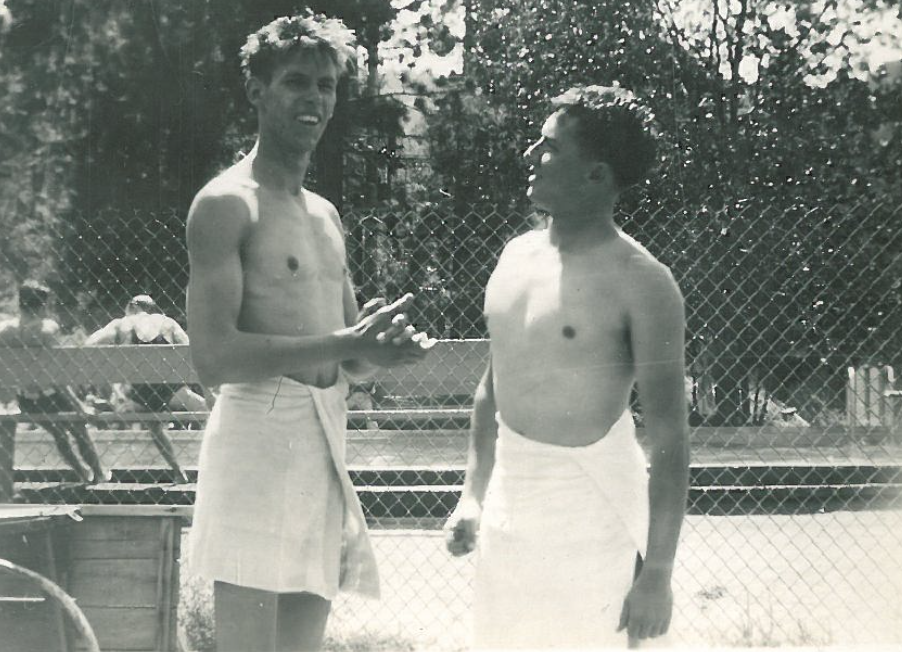
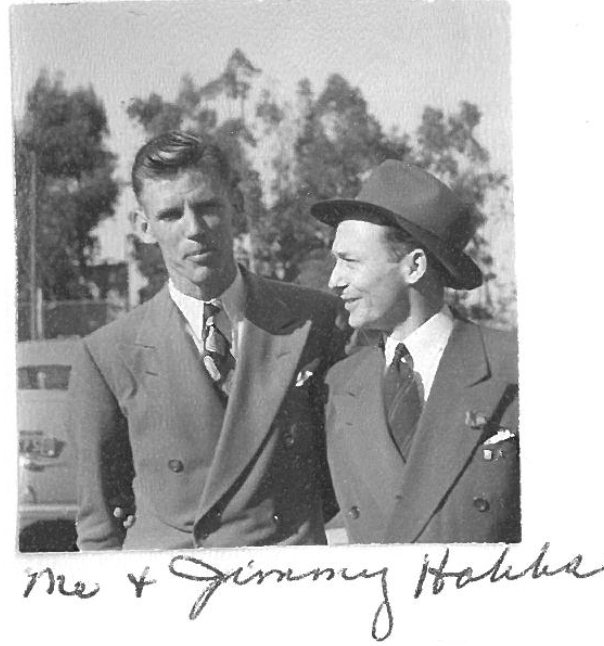
A Brief Account of My Wartime Experience
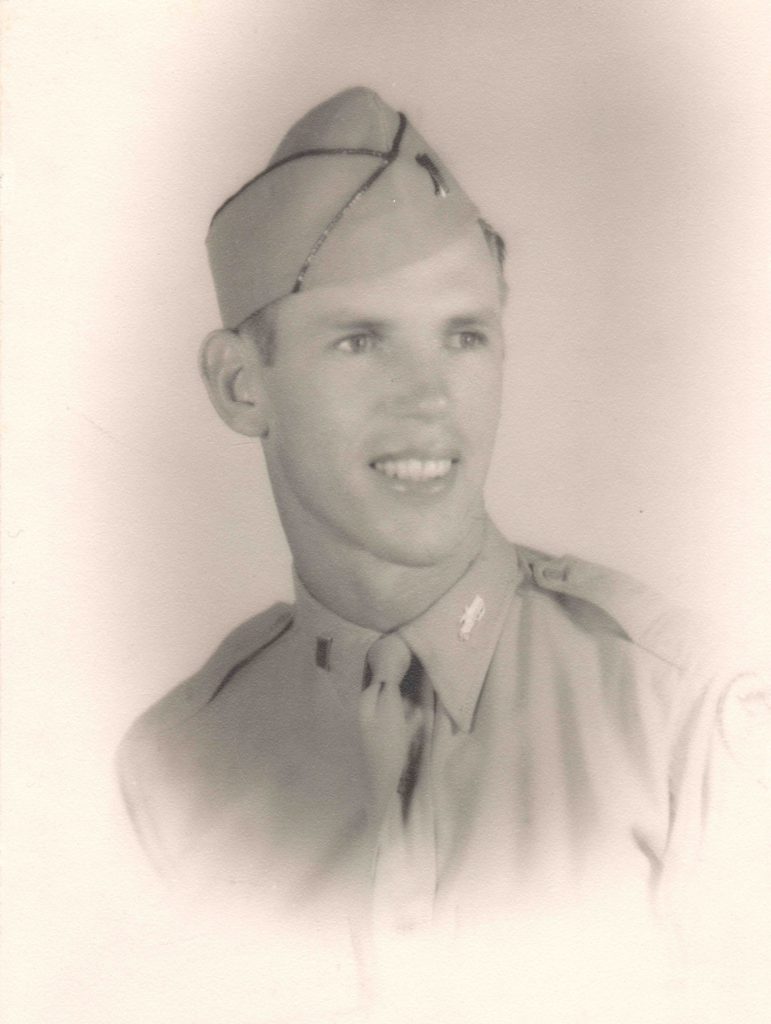

Howard attended Beginning and Advance Tank Destroyer Training at Camp Hood, Texas
Howard K. Smith Military Training Drills
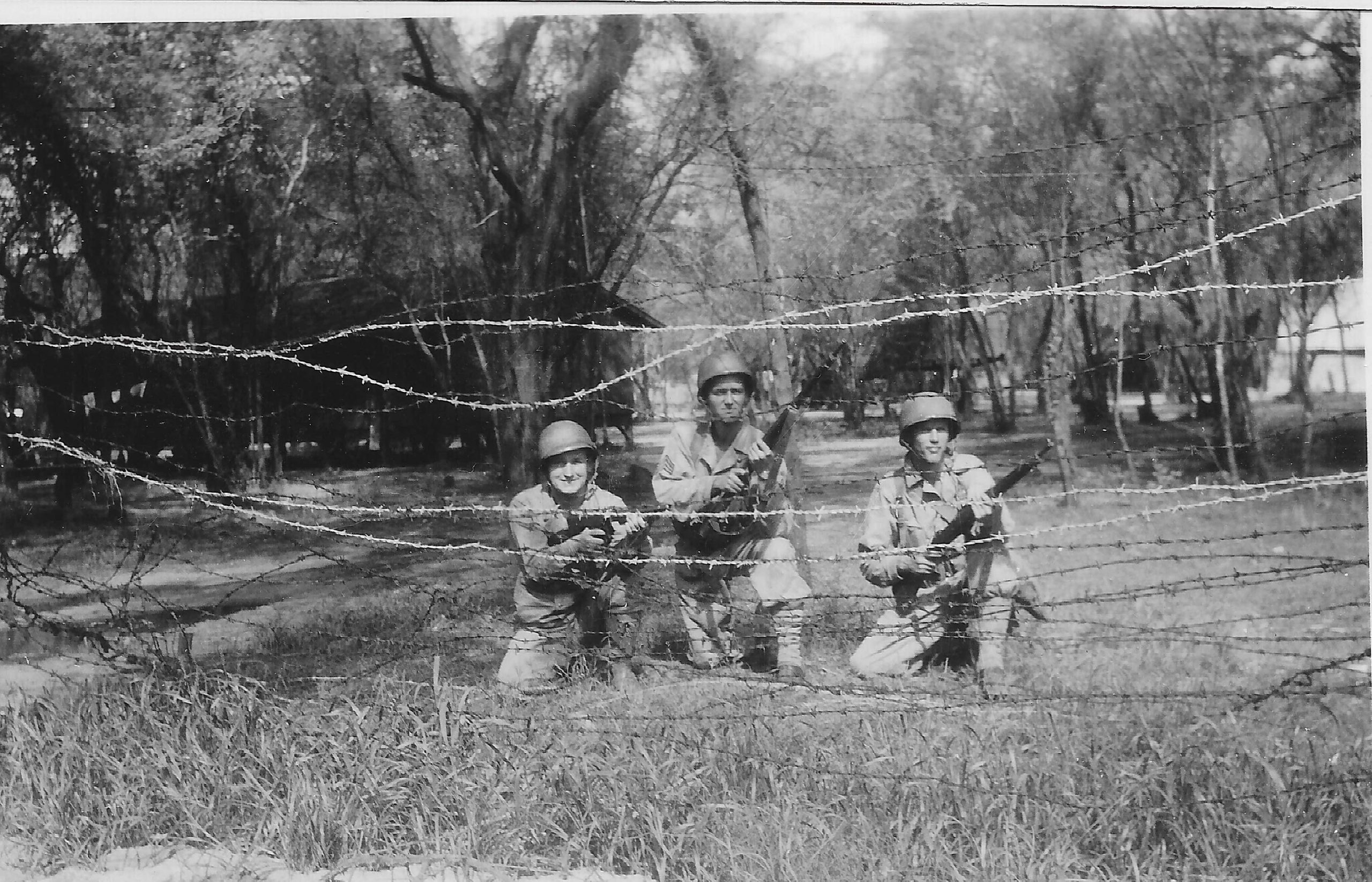
Howard is on the Far Right
My wartime service, briefly was as follows: Induction at Fort McArthur on March 25, 1942. After preliminary processing which included equipment issue, shots, and classification tests that lasted about 3 days we found ourselves on a troop train going East. I was aware by this time that I was assigned to a new combat unit called “The Tank Destroyers”. The title seemed self explanatory– but we were very uninformed at this point as to the exact type of operation we would perform.
Our train stopped out near Riverside, Calif. and after spending the night in barracks at Camp Haan we were rolled out to take our place in a motorcade– heading back to Los Angeles! It was surprising , indeed , to discover we were returning to the old Warner Ranch– behind the film studio in Hollywood known as “Gopher Flats”. We entertained for Fort Lewis, Washington, to receive the balance of our basic training. While at Fort Lewis, earned my Corporal stripes and became a security section leader June 14, 1942, which gave me some satisfaction of accomplishment. My first company commander was Capt. Bass later replaced by Lt. Nelson whom I considered one of the finest men I knew in the service. Prior to departure for POE at Camp Stoneman, August of 1942 , a Capt. Taylor was made our Co. Commander. This was a let down because he was not well liked and was known to be somewhat of a drinker. He was from Lodi, Calif., and we referred to him as the “Lodi Wino”
Camp Stoneman was a staging area for overseas movement and we were not there long before we were on a boat in San Francisco and on our way into the Pacific. No one new our particular goal but it turned out to be Island security in the Hawaiian Isles. We had the good fortune to be located on the island of Kauai and what a beautiful spot! Much could be written detailing activities and events here but it might be best to refer the reader to my daily diaries which covers this period. Suffice it to say I made Buck Sergeant Oct. 8, 1942 while here and my application for OCS was approved and on Jan. 7, 1943. I found myself returning to the United States to attend Officer Candidate School at Camp Hood, Texas.
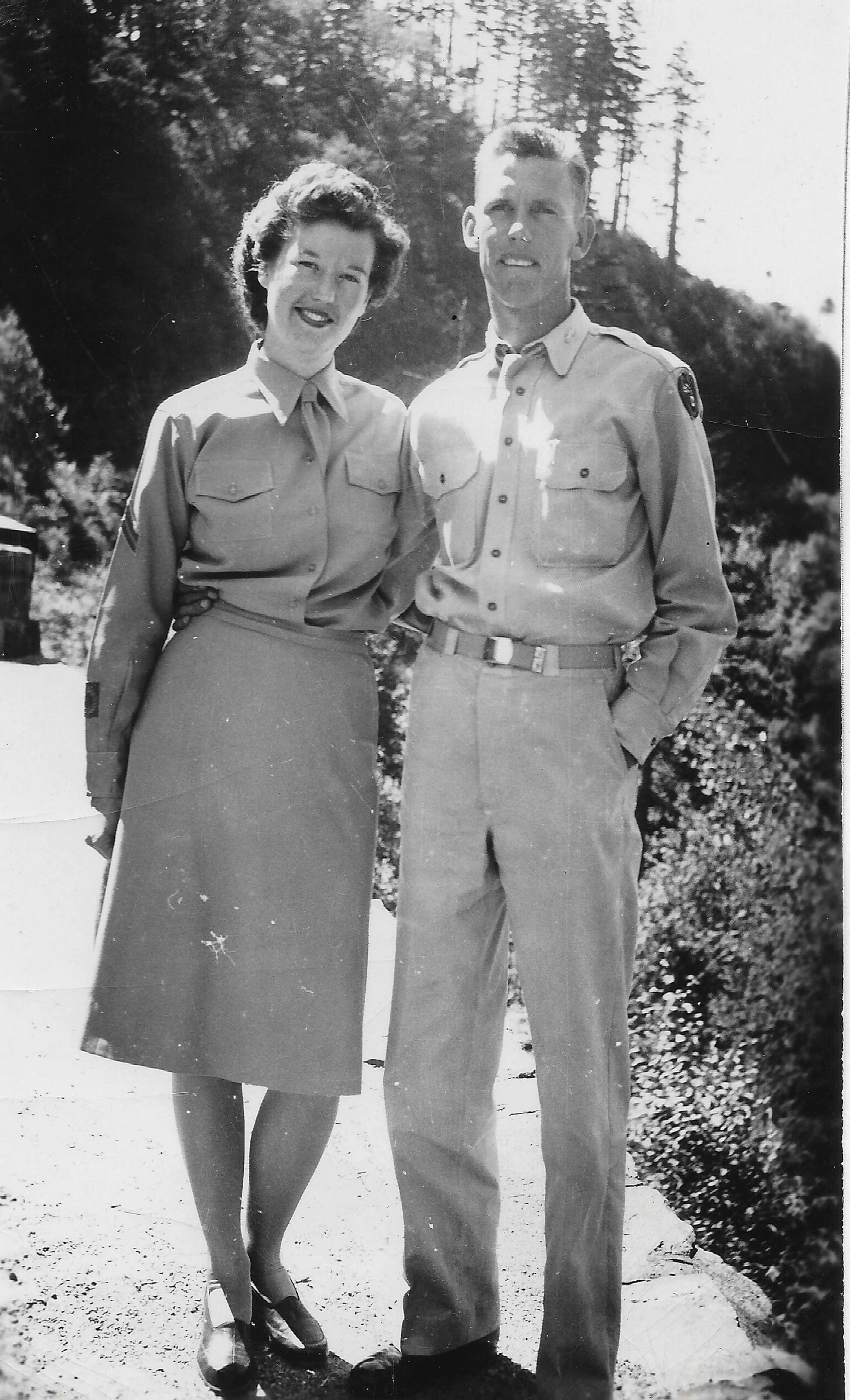

Private Margie Gunderson, my half-sister and Second Lieutenant Howard K. Smith 1944
A surprise visit was made to my Mother’s house on Griffith Park Drive in Burbank. She had no idea I was returning and was truly stunned by my sudden appearance on January 22, 1943. This was a memorable visit because it was the last time I saw my dear mother before her death. I was given leave at OCS to fly to the funeral in September 1943. With her passing my home ties were severed. The feeling overcame me that there was no place to call home. Mother died at the age of 59, having been born in 1884.
Officer Candidate School was a great challenge to me and brought fulfillment on May 10, 1943, when I graduated with the gold bar of second Lieutenant. First assignment took me to a Tank Destroyer Staff at South Camp Hood, Texas. My first commander was Lt. Colonel Lafayette D. Matthews who was to gain my sincerest personal regards and become my lasting and respected friend.
Howards Diary January- June 1943
Brief Synopsis of Howard’s Diary–Once Howard steps foot in Fort Hood, Texas it’s a wild ride learning all the information to become an officer in the Army. The first three weeks of training have gone by and Howard has learned a lot. Quarantined for measles, getting reprimanded for leaving his slipper under his bed and of course smiling can get you into trouble. By the end of this three weeks he will learn how to fight close range, make grenades and use machine guns. It’s a crazy three weeks with so much going on. Well it so happens that Howard was quarantined again for something else this time (I’ll let you read to find out). Someone didn’t like his hair and gave him a hard time. He has learned about so many different things… Guns, aircraft recognition, radios, tanks and so much more. His hands have been giving him some problems and his eyes were bothering him. It’s a wild ride in the army. Just a few highlights from March. If you read it you will learn so much more. It’s been a lot of fun to learn the in’s and outs of military life during WWII.
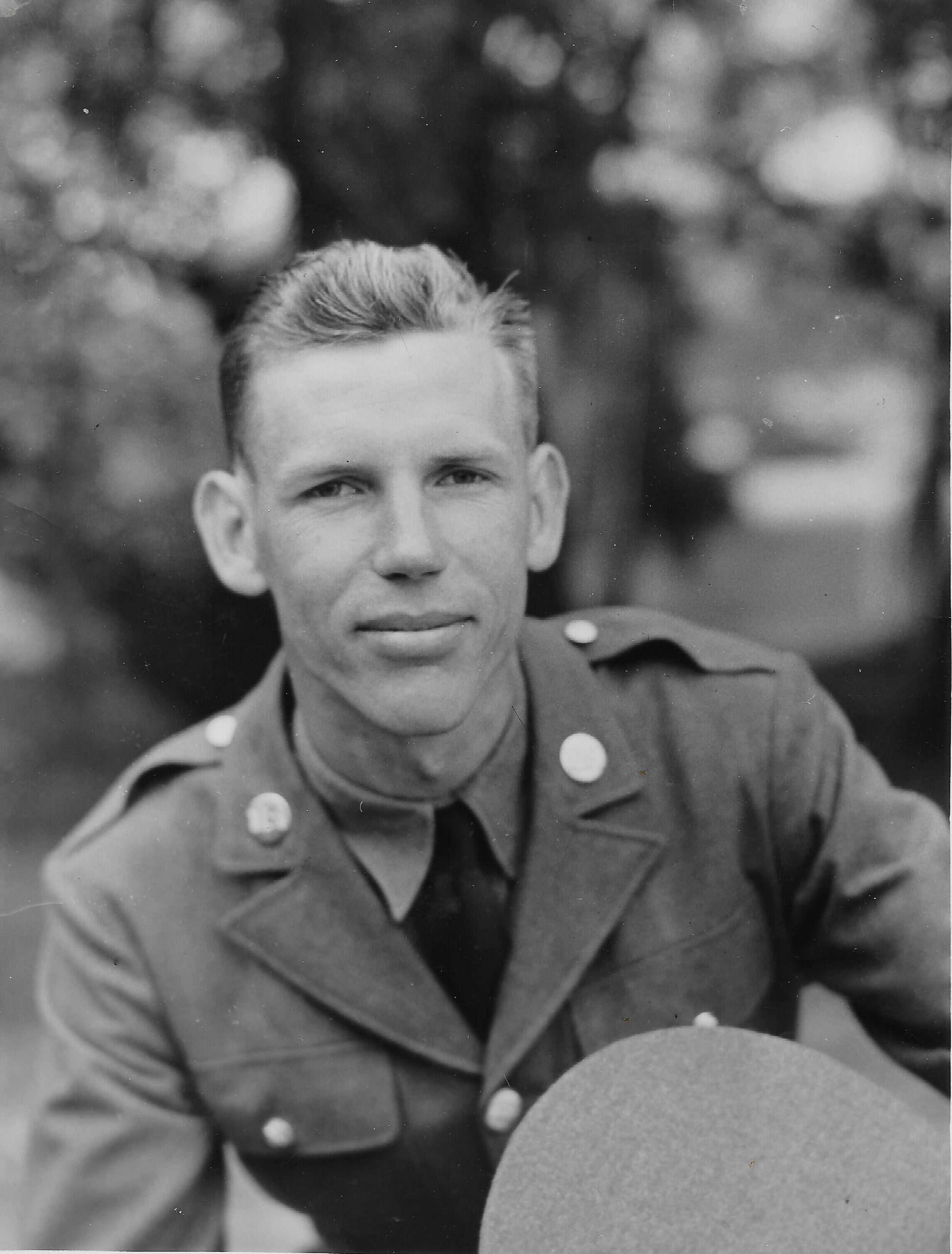
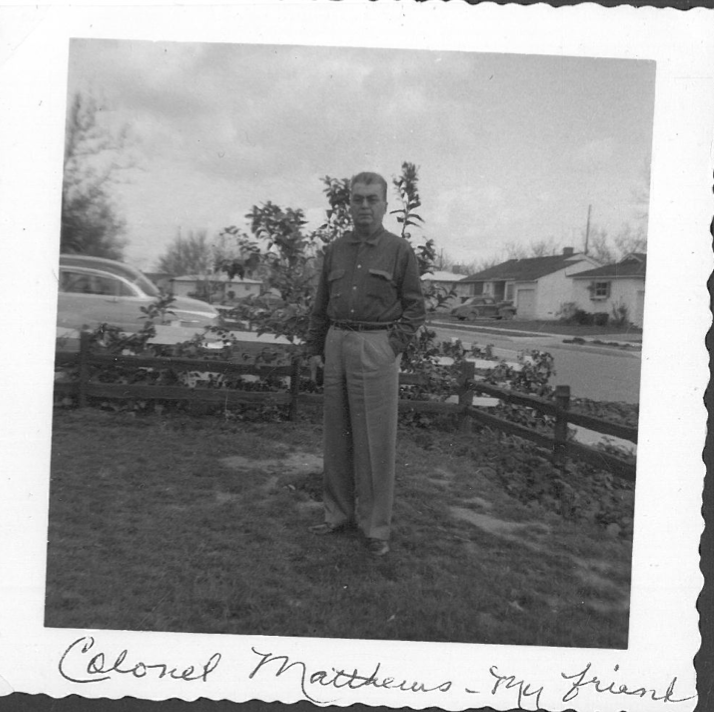
I feel it not necessary here to chronologically outline the many experiences and troop shifts made during the balance of my service (Much is covered by the diary). Briefly, however, my schools and experience brought me to the rank of 1st Lieutenant and later Captain. I served as Assistant S-2 Officer, Line Platoon Leader, and Company Commander. I attended such service schools as Tank Destroyer, both beginning and advanced at Camp Hood, Texas and the advanced Mechanized Calvary School at Fort Riley, Kansas. My commander was preparing to send me to the Command and General Staff School at Fort Leavenworth when we were ordered to maneuvers in Louisiana. At this point I was still a liason and intelligence officer with the 18th Tank Destroyer Staff. The invasion of Germany had taken place and we were rushing most of our Tank Destroyer Battalions overseas. It was Colonel Matthews greatest desire to take the Group Staff over but we never made it.
After the battle of the Bulge, which depleted our European armed forces, we were rushed to Fort Knox, Kentucky to assist in a crash program designed to train replacement tank crewmen. Here at Fort Knox I was to meet the girl who later became my wife, Elizabeth Camille Helm. Though I’m writing this account 16 years after our marriage and admitting that there have been some serious and critical differences, I feel the Lord blessed this union and gave me the very best girl to be my life’s companion and the mother of our five wonderful children.
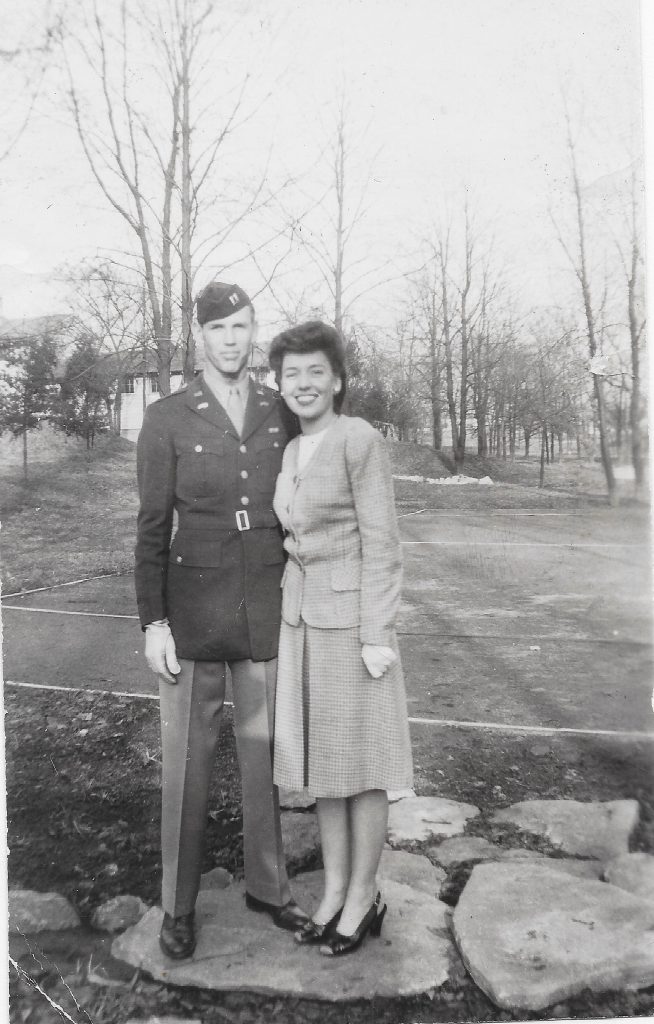

Captain Howard K Smith and Camille Helm–Our First Date 1944
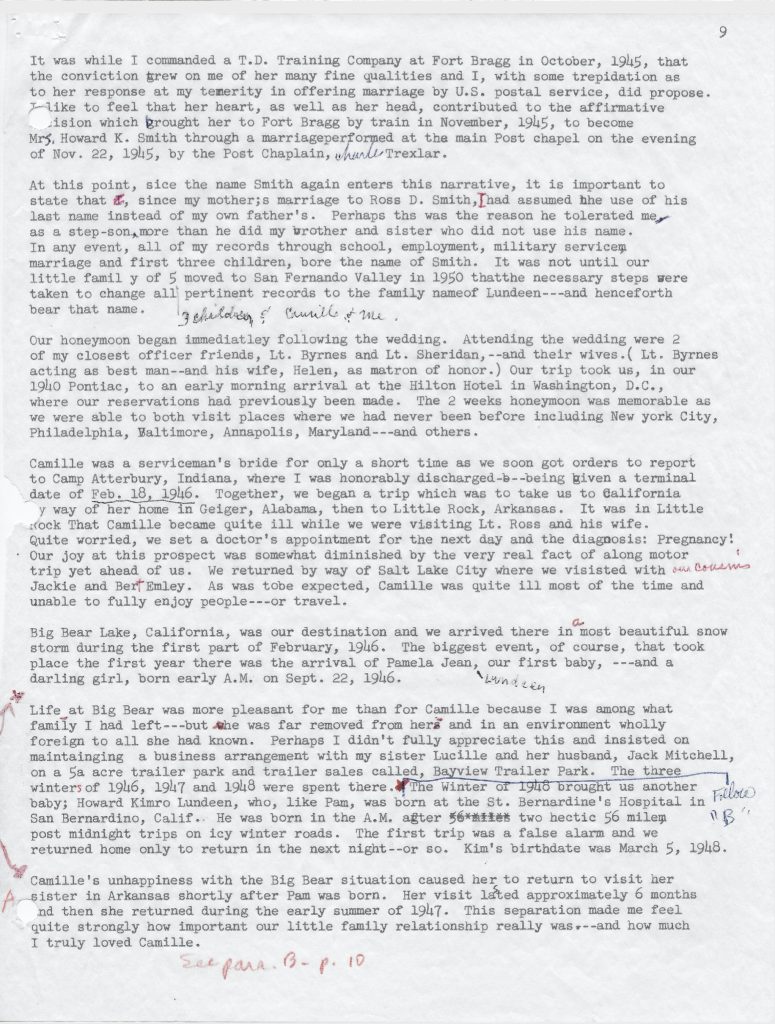
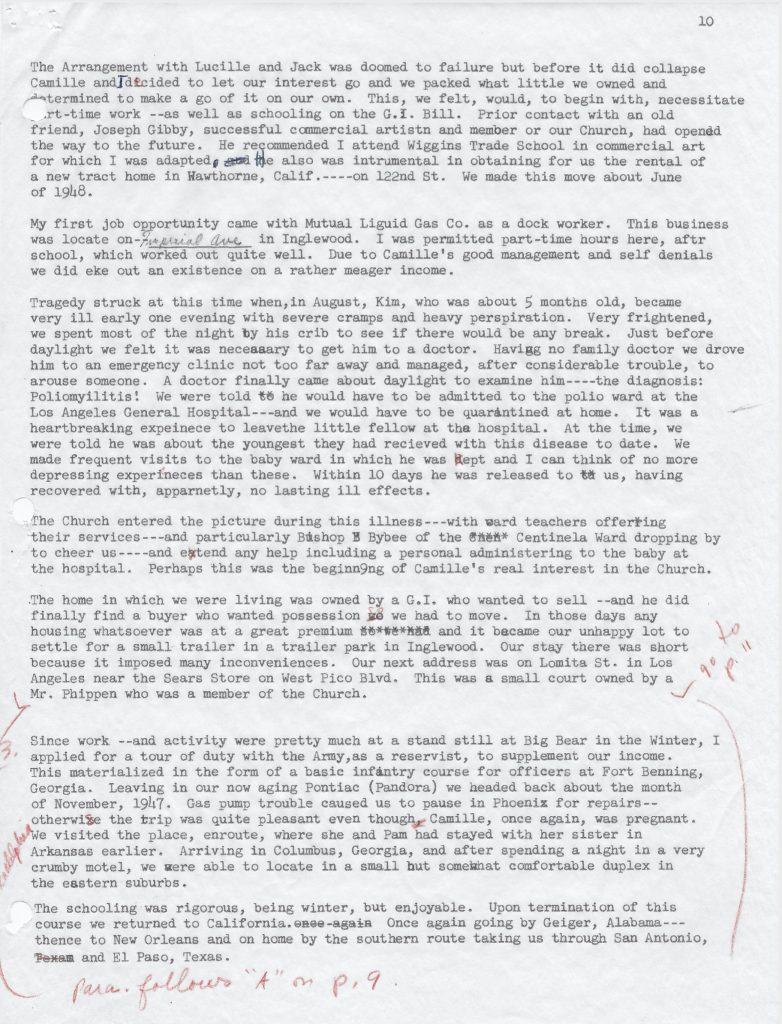
It was while I commanded a Tank Destroyer Training Company at Fort Bragg in October 1945 that conviction grew on me of her many fine qualities and I, with some trepidation as to her response at my temerity in offering marriage by U. S. postal service, did propose. I like to feel that her heart, as well as her head, contributed to the affirmative decision which brought her to Fort Bragg by train in November 1945, to become Mrs. Howard K Smith through a marriage performed at the main Post chapel on the evening of Nov. 22, 1945 by the Post Chaplain, Charles Trexlar.
At this point, since the name Smith again enters this narrative, it is important to state that since my mother’s marriage to Ross D. Smith, I had assumed the use of his last name instead of my own father’s. Perhaps this was the reason he tolerated me as a step-son more than he did my brother and sister who did not use his name. In any event, all of my records through school, employment, military service marriage and first three children, bore the name of Smith. It was not until our little family of three children and Camille moved to San Fernando Valley in 1950 that the necessary steps were taken to change all pertinent records to the family name of Lundeen and henceforth bear that name.
Our honeymoon began immediately following the wedding. Attending the wedding were 2 of my closest officer friends, Lt. Byrnes and Lt. Sheridan, and their wives. (Lt. Byrnes acting as best man and his wife, Helen as matron of honor.) Our trip took us, in our 1940 Pontiac, to and early morning arrival at the Hilton Hotel in Washington D.C., where our reservations had previously been made. The 2 week honeymoon was memorable as we were able to both visit places where we had never been before including New York City, Philadelphia, Baltimore, Annapolis, Maryland and others.
Camille was a serviceman’s bride for only a short time as we soon got orders to report to Camp Atterbury Indiana, where I was honorable discharged being given a terminal date of Feb. 18, 1846. Together, we began a trip which was to take us to California …. way of her home in Geiger, Alabama, then to Little Rock, Arkansas. It was in Little Rock that Camille became quite ill while we were visiting Lt. Ross and his wife. Quite worried, we set a doctor’s appointment for the next day and the diagnosis: Pregnancy! Our joy at this prospect was somewhat diminished by the very real fact of a long motor trip yet ahead of us. We returned by way of Salt Lake City where. we visited with our cousins Jackie and Bert Emley. As was to be expected, Camille was quite ill most of the time and unable to fully enjoy people… or travel.
Big Bear Lake, California, was our destination and we arrived there in a most beautiful snow storm during the first part of February, 1946. The biggest event, of course, that took place the first year there was the arrival of Pamela Jean, our first baby, and a darling girl, born early A.m. on Sept. 22, 1946
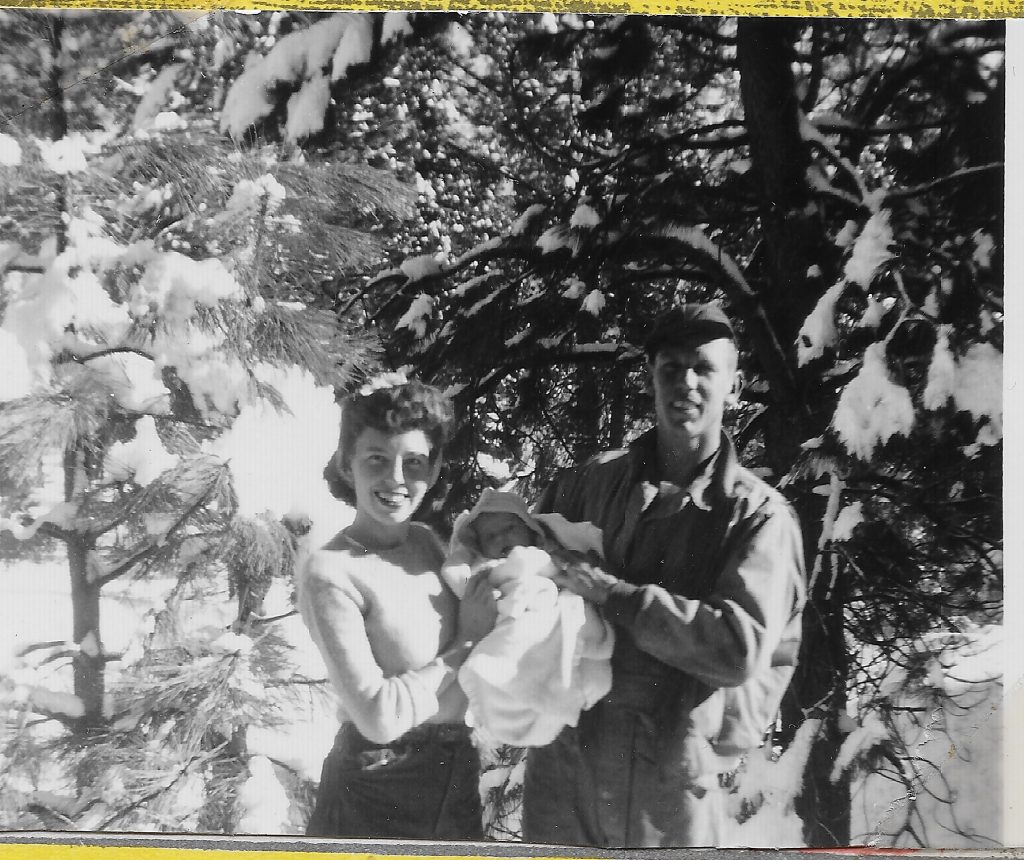
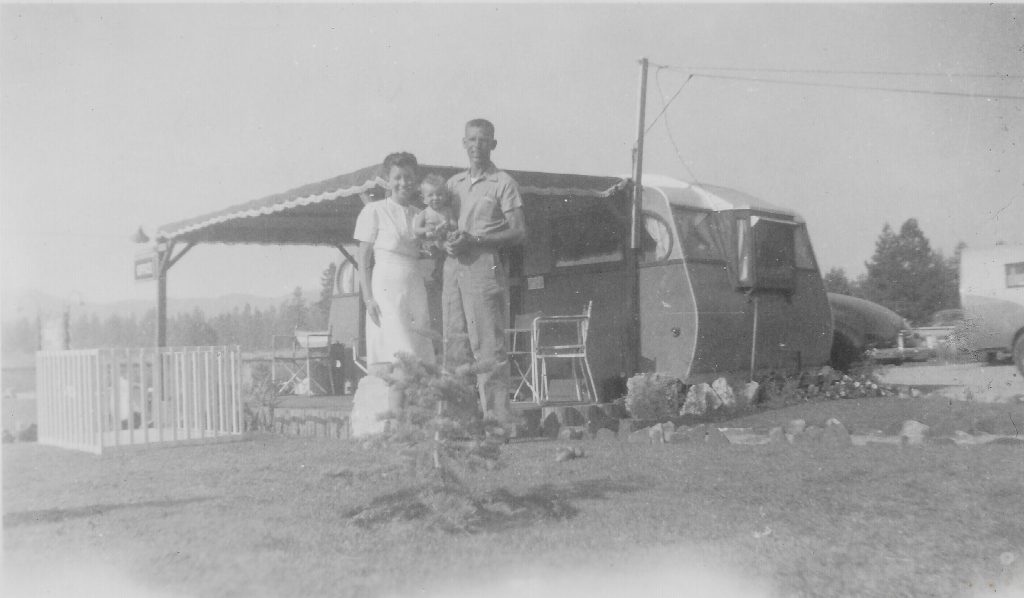

Life at Big Bear was more pleasant for me than for Camille because I was among that family I had left but she was far removed from hers and in an environment that was wholly foreign to all she had known. Perhaps I didn’t fully appreciate this and insisted on maintaining a business arrangement with my sister Lucille and her husband, Jack Mitchell on a 5 acre trailer park and trailer sales called Bayview Trailer Park. The three winters of 1946, 1947, 1948 were spent there. The winter of 1948 brought us another baby; Howard Kimro Lundeen, who, like Pam, was born at the St. Bernardine’s Hospital in San Bernardino, California. He was born in the a.m after 2. Hectic 56 mile post midnight trips on icy winter roads. The first trip was a false alarm and we returned home only to return the next night..or so. Kim’s birthdate was March 5, 1948.
Camille’s unhappiness with the Big Bear situation caused her to return to visit her sister in Arkansas shortly after Pam was born. Her visit lasted approximately 6 months and the she returned during the early summer of 1947. This separation made me feel quite strongly how important our little family relationship really was … and how much I truly loved Camille.
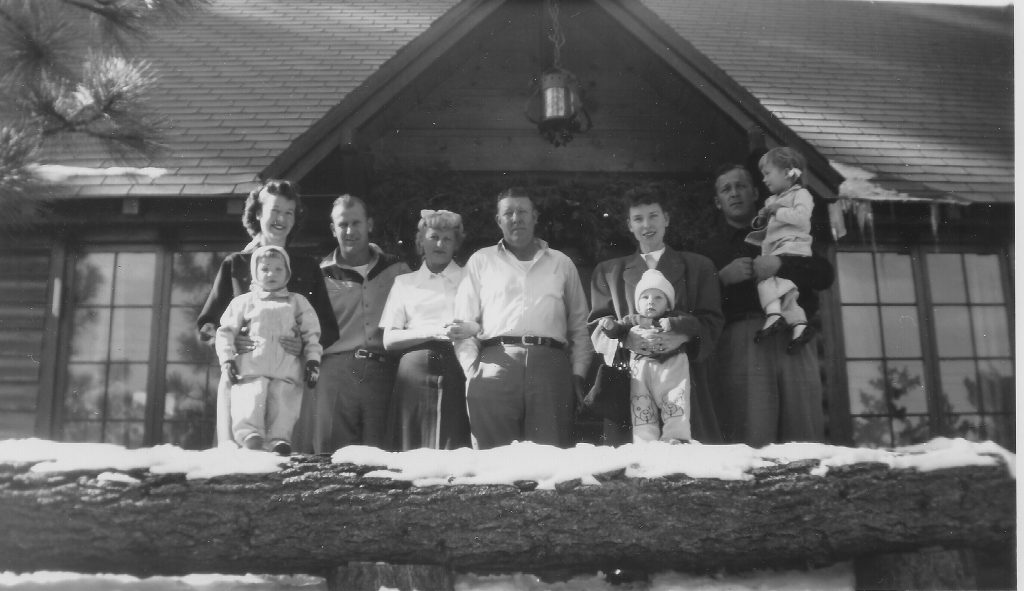

The arrangement with Lucille and John was doomed to failure but before it did collapse Camille and I decided to let our interest go and we packed what little we owned and determined to make a go of it on our own. This we felt, would necessitate part time work as well as schooling on the G.I. Bill. Prior contact with an old friend, Joseph Gibby, successful commercial artisan and member of our Church, had opened the way to the future. He recommended I attend Wiggins Trade School in commercial art for which I was adapted. He also was instrumental in obtaining for us the rental of a new tract home in Hawthorne, Calif., on 122nd St. We made this move about June of 1948.
My first job opportunity came with Mutual Liquid Gas Co. as a dock worker. This business was located on Imperial Ave. in Inglewood. I was permitted part time hours here, after school, which worked out quite well due to Camille’s good management and self denials we did eke out an existence on a rather meager income.
Tragedy struck at this time when in August Kim, who was about five months old, became very ill early one evening with severe cramps and heavy perspiration. Very frightened, we spent most of the night by his crib to see if there would be any break. Just before daylight we felt it was necessary to get him to a doctor. Having no family doctor we drove him to an emergency clinic not too far away and managed, after considerable trouble, to arouse someone. A doctor finally came about daylight to examine him, the diagnosis: Polyiomylitis! We were told he would have to be admitted to the polio ward at the Los Angeles General Hospital and we would have to be quarintined at home. It was a heartbreaking experience to leave the little fellow at the hospital. At the time, we were told he was about the youngest they had received with this disease to date. We made frequent visits to the baby ward in which he was kept and I can think of no more depressing experiences than these. Within 10 days he was released to us, having recovered with apparently no lasing ill effects.
The Church entered the picture during this illness with ward teachers offering their services and particularly Bishop Bybee of the Centinela WArd dropping by to cheer us and extend any help including a personal administering to the baby at the hospital. Perhaps this was the beginning of Camile’s real interest in the Church.
The home in which we were living was owned by a G.I. who wanted to sell and he did finally find a buyer who wanted possession so we had to move. In those days any housing whatsoever was at a great premium and it became our unhappy lot to settle for a small trailer in a trailer park in Inglewood. Our stay there was short because it imposed many inconveniences. Our next address was on Lomita St. in Los Angeles near the Sears Store on West Pico Blvd. This was a small court owned by a Mr. Phippen who was a member of the Church.
Since work and activity were pretty much at a stand still at Big Bear in the Winter, I applied for a tour of duty with the Army, as a reservist, to supplement our income. This materialized in the form of a basic infantry course for officers at Fort Bennings, Georgia. Leaving in our now aging Pontiac (Pandora) we headed back about the month of November, 1947. Gas pump trouble caused us to pause in Phoenix for repairs– otherwise the trip was quite pleasant even though, Camille, once again was pregnant. We visited the place, enroute where she and Pam had stayed with her sister in Arkansas earlier. Arriving in Columbus, Georgia, and after spending the night in a very crummy motel, we were able to locate in a small but somewhat comfortable duplex in the eastern suburbs.
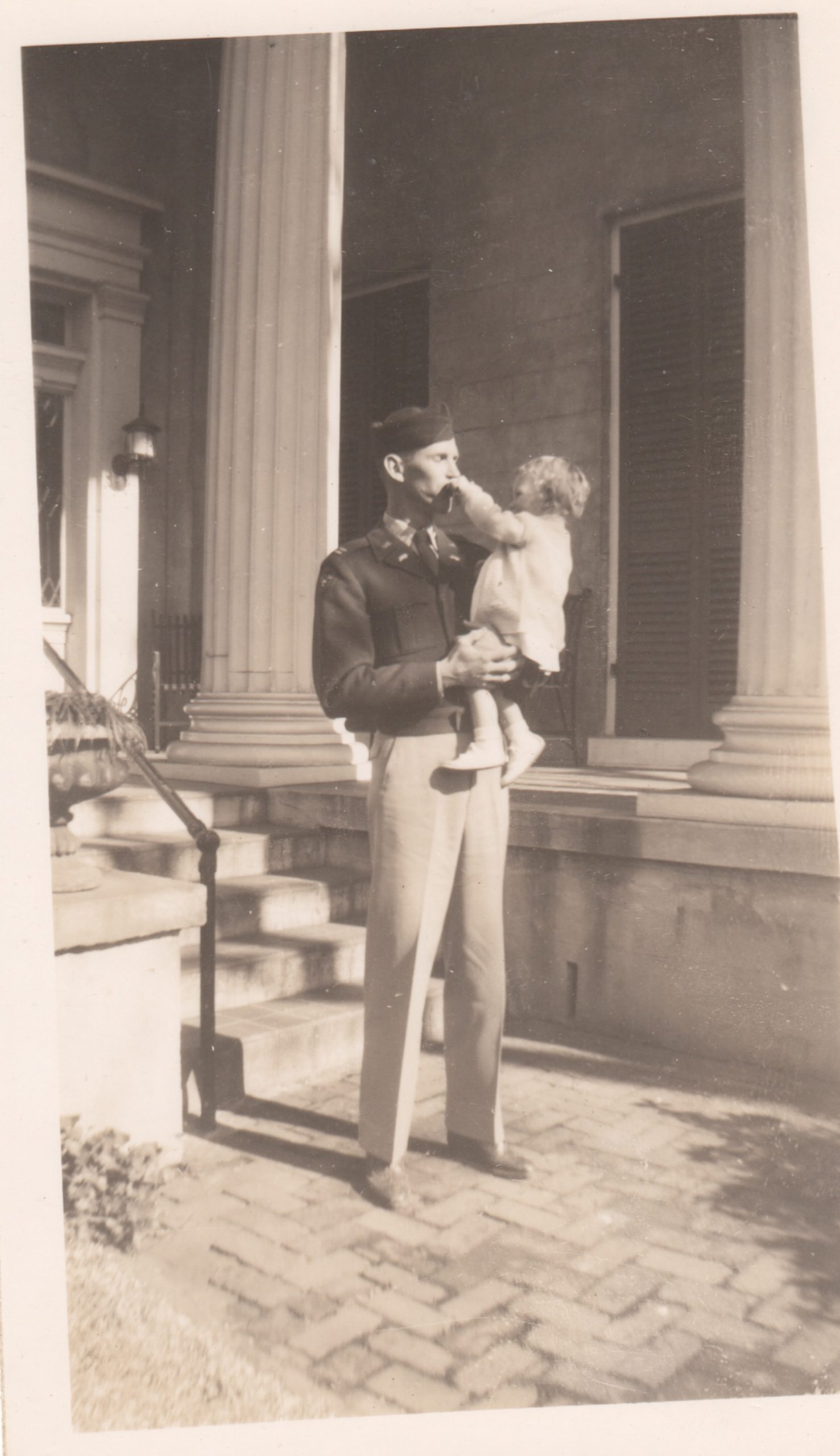
The schooling was rigorous, being winter, but enjoyable. Upon termination of this course we returned to California . Once again going through Geiger, Alabama thence to New Orleans and on home by the southern route taking us through San Antonio, and El Paso, Texas.
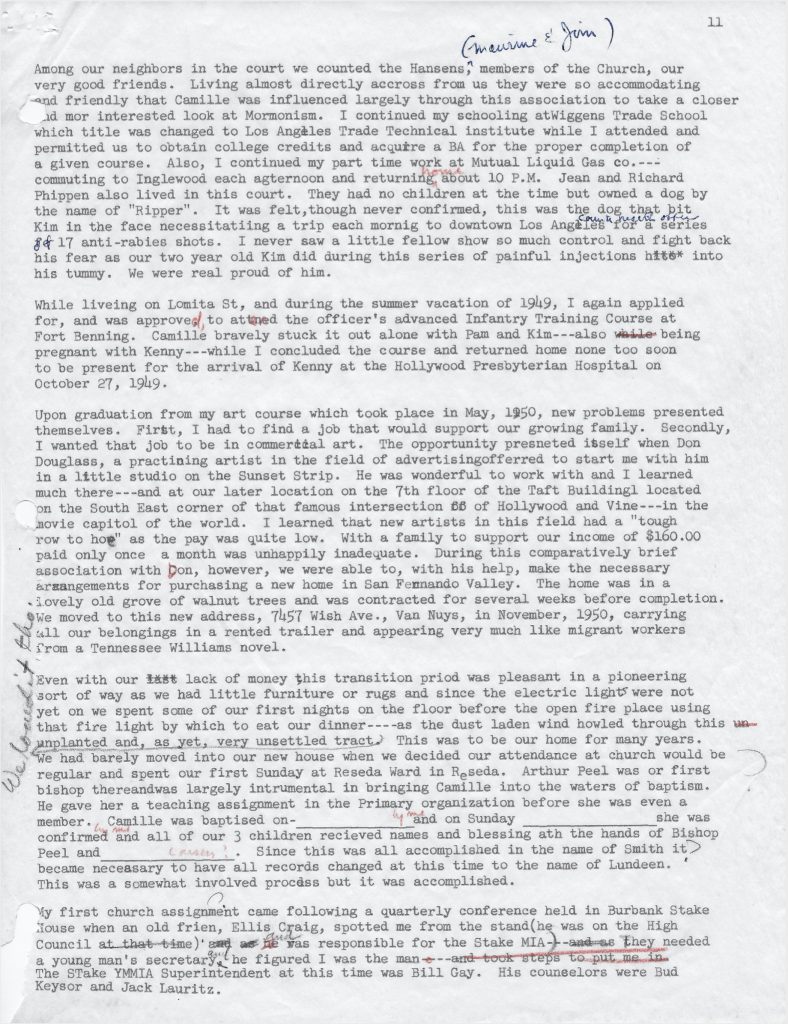

Among our neighbors in the court we counted the Hansens, members of the Church, our very good friends. Living almost directly across from us they were so accommodating and friendly that Camille was influenced largely through this association to take a closer and more interested look at Mormonism. I continued my schooling at Wiggens Trade School which title was changed to Los Angeles Trade Technical Institute while I attended and permitted us to obtain college credits and acquire a BA for the proper completion of a given course. also, I continued my part time work at Mutual Liquid Gas Co. commuting to Inglewood each afternoon and returning about 10P.M. Jean and Richard Phippen also lived in this court. They had no children at the time but owned a dog by the name of “Ripper”. It was felt, though never confirmed, this was the dog that bit Kim in the face necessitating a trip each morning to downtown Los Angeles for a series of 17 anti-rabies shots. I never saw a little fellow show so much control and fight back his fear as our two year old Kim did during this series of painful injections into his tummy. We were real proud of him.
While living on Lomita St., and during the summer vacation of 1949, I again applied for and was approved to attend the officer’s advanced Infantry Training Course at Fort Benning. Camille bravely stuck it out alone with Pam and Kim, also being pregnant with Kenny, while I concluded the course and returned home none too soon to be present for the arrival of Kenny at the Hollywood Presbyterian Hospital on October 27, 1949.
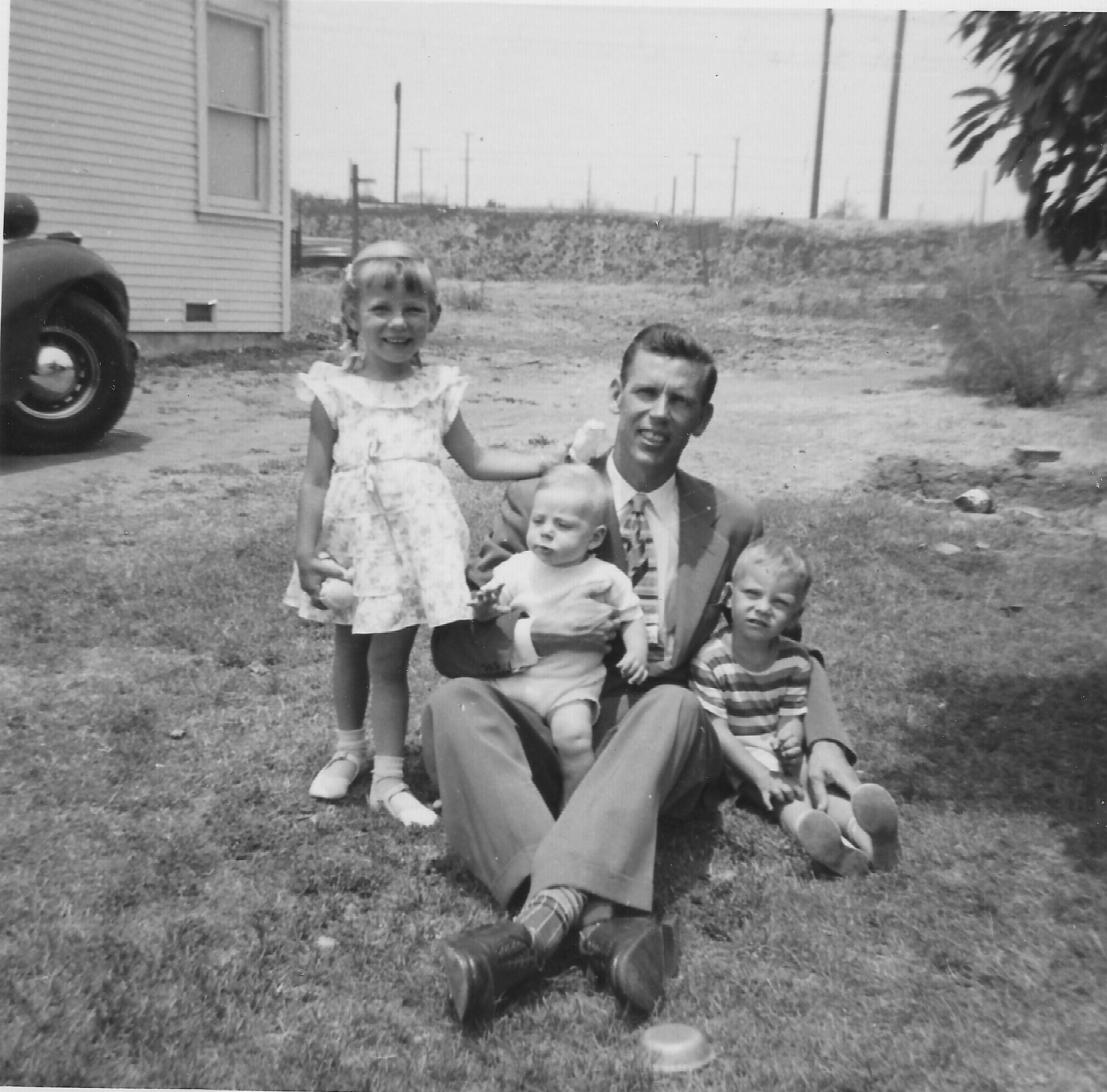
Upon graduation from my art course which took place in May 1950, new problems presented themselves. First, I had to find a job that would support our growing family. Secondly, I wanted that job to be in commercial art. The opportunity presented itself when Don Douglas, a practicing artist in the field of advertising offered to start me with him in a little studio on the Sunset Strip. He was wonderful to work with and I learned much there; and at our later location on the 7th floor of the Taft Building. I located on the South East corner of that famous intersection of Hollywood and Vine, in the movie capitol of the world. I learned that new artists in this field had a “tough row to hoe” as the pay was quite low. With a family to support our income of $160.00 paid only once a month was unhappily inadequate. During this comparatively brief association with Don however, we were able to, with his help, make the necessary arrangements for purchasing a new home in San Fernando Valley. The home was in a lovely old grove of walnut trees and was contracted for several weeks before completion. We moved to this new address, 7457 Wish Ave., Van Nuys, in November, 1950, carrying all our belongings in a rented trailer and appearing very much like migrant workers from a Tennessee Williams novel.
Even with our lack of money this transition period was pleasant in a pioneering sort of way as we had little furniture or rugs and since the elctric lights were not yet on we spent some of our first nights on the floor before the open fire place using that fire light by which to eat our dinner as the dust laden wind howled through this unplanted, and as yet, very unsettled tract. We loved it tho! this was to be our home for many years. we had barely moved into our new house when we decided our attendance at church would be regular and spent our first Sunday at Reseda Ward. arthur Peel wasour first bishop there and was largely strumental in bringing Camille into the waters of baptism. He gave her a teaching assignment in the Primary organization before she was even a member. Camille was baptized and confirmed by me and all of our three children received names and blessings at the hands of Bishop Peel and myself. Since this was all accomplished in the name of Smith it became necessary to have all records changed at this time to the name of Lundeen. This was a somewhat involved process but it was accomplished.
My first church assignment came following a quarterly conference held in Burbank Stake House when an old friend, Ellis Craig, spotted me from the stand (he was on the High Council) and was responsible for the MIA. They needed a young man’s secretary and he figured I was the man.
A big change in employment took place in November of 1951. Mr. Douglas had a setback in his advertising clientele and felt he could not maintain an assistant so I immediately searched for new employment. I believe it was Ellis Craig who suggested I call Bill Gay at his office with regard to employment at Hughes Productions. This I did and learned that he was hiring LDS Men at that time as a sort of personal Research Staff for Mr Hughes. Bill felt they could use and artist or draftsman and, consequently, arranged for the necessary interviews which were accomplished and I was put on the payroll November 19, 1951. Our income continued fairly meager, but better than it had been. This job provided many more desirable fringe benefits never enjoyed before.
I must confess they have been interesting years working for Howard Hughes. the Research Staff, as much as composed of a fine array of talented and well educated Men, several having their degrees in Political Science, Law, Languages, Physics, and Math. This organization was somewhat doomed to begin with because Mr Hughes, himself, never fully realized it’s possibilities or potential. Consequently, these fine men eventually dwindled away to other more demanding and more rewarding pursuits in their respective fields. For myself, the activities in which I engaged became more varied including a good deal of clerical work. Trips out of town became somewhat frequent and took me to Las Vegas in 1953, to Miami, Florida, in 1954, back to Palm Beach, Florida in 1955. (During this trip, which lasted about 10 weeks, Camille joined me for a week and we took the opportunity to visit Nassau, in the Bahamas. ) Other assignments have carried me to San Diego, La Jolla, Balboa, Monterey and Carmel, Santa Barbara, Phoenix, and Chyenne, Wyoming. On some of these occasions, it was my opportunity to work quite closely with Mr. Hughes who was often accompanied by his wife, Jean. They would fly to these locations in his own personal Convair 440 which he always piloted. I would meet them at the airport and lead or accompany them to the place which we had provided by our advance work. Staying with one employer for so long has had, among other benefits, the salutary effect of increased income which, without making our little family too affluent or independent, certainly has eased the domestic economics of earlier periods.
Later Camille’s Baptism our determination grew to have our marriage solemnized in the temple of our Lord for eternity and our children sealed to us. This we accomplished July 31, 1953 at the Manti Temple in Utah where we had driven in a 1948 Chevrolet sedan which was a necessary replacement of our old 1940 Pontiac. This was one of the greatest steps forward our little family had taken.
Not too long after this I was made Stake YMIA Superintendent to be shortly followed by another calling to be bishop of a newly created Van Nuys III Ward. This was an honor and a privilege I never suspected, especially so when the Apostle, Elder Harold B Lee laid his hands on my head in Burbank stake House to ordain me a High Priest and then a Bishop in the Church of Jesus Christ of Latter-Day Saints. Perhaps more should be included here about my experiences in this calling. Suffice it to say, I had the complete support of my wife and children through the term of this responsibility and will always fondly remeber my associates and wonderful, willing, and cooperative ward members during those three years. I shall never forget such counselors as Harry Arend, Jim Kenning and Reeves Brady. When the completion of our new stake building, creation of new stakes and wards, my release as bishop was affected, I was immediately called to the San Fernando Stake High Council. Since that change I have enjoyed the great blessing of serving closely with fine men of the Priesthood who are dedicated to the service of the Lord. Serving under President Don C. Brown has been a cherished experience.
About 8 years passed from the birth of Kenny to our next baby boy, Kris Alan, who came to us at the Van Nuys Community Hospital in November 1957. Then on September 21, 1960, at the West Valley Community Hospital, we were granted the great blessing of another baby boy whom we named Kelvar James. Now we feel our family is complete and we are prepared to face the future together for whatever it may bring and that we can do this being humble and obedient to the Lord, I pray in the name of his Son, Jesus Christ.
A Tribute To My Father by Pam
My father is 6’1″ which is average height, but I remember as a child knowing that he was the tallest man around. My mother was so supportive and came to all school and church programs where I was involved. I was always proud of her and felt that she was very beautiful. My patriarchal blessing reminds me that the Lord was especially mindful of me in giving me to my parents for “the Lord lovers your Father and Mother and He asks you to honor them that their days may be long upon the land.”
My father came from a strong pioneer heritage. However he also struggled with difficulties in his childhood because of a broken home. When he was about seven, he lived with Grandma Peterson in East Garland, Utah, and it was here that he received a foundation in the Gospel which was to blossom later. he served as a captain in the Army during World War II and then married my mother in 1945– this Souther Methodist girl from Mississippi. He brought her right to Southern California and I was born a year later, their first child and only daughter.
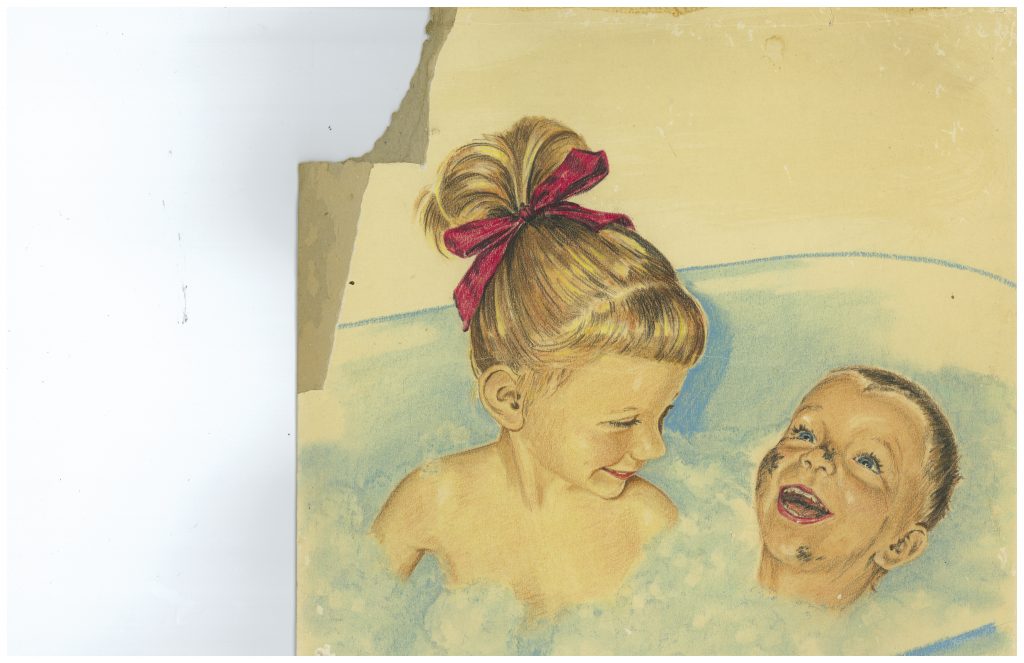
My father is an artist. He trained as a graphic artist and was hired by a commercial artist in Hollywood and Vine Streets, where his work included projects for Walt Disney. Then later he was hired as a member of the personal staff of Howard Hughes. We had many interesting experiences growing up because of this relationship with Howard Hughes….. My father has magnified his priesthood. My mother and father have remained true to the covenants they made in the temple. (More to come)
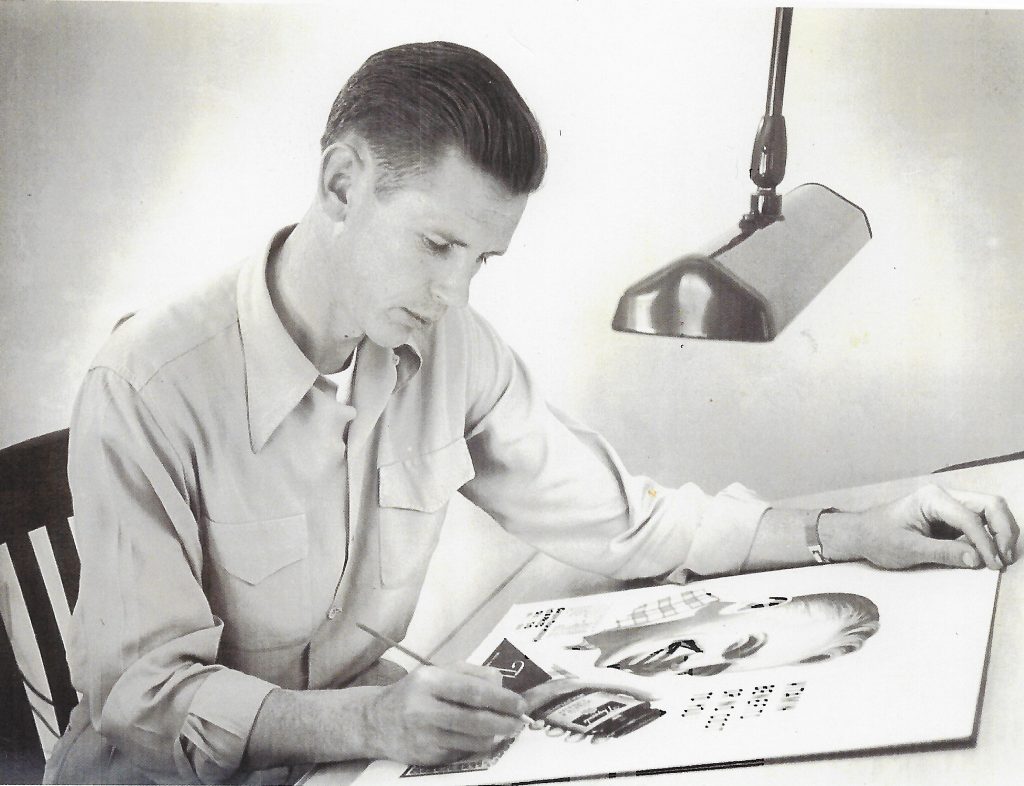
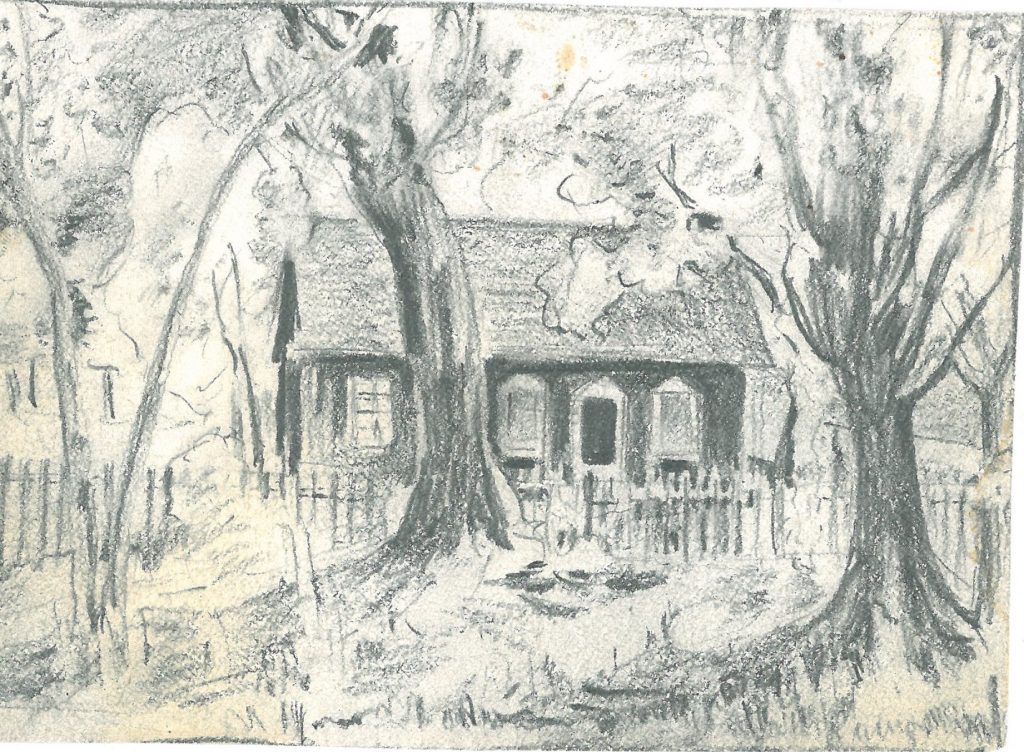
A sketch of an old home in Torey, Utah while on a hunting trip to Henry’s Mountain
